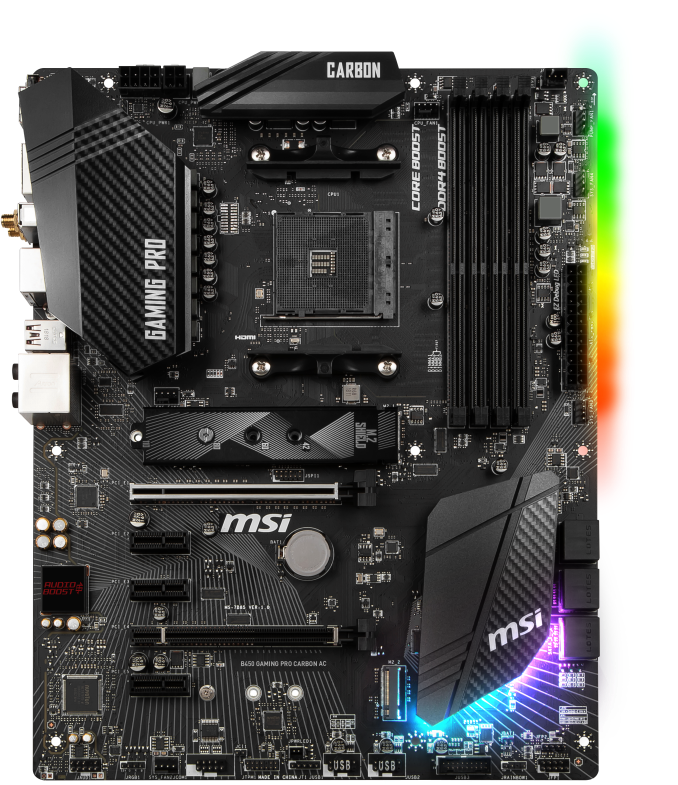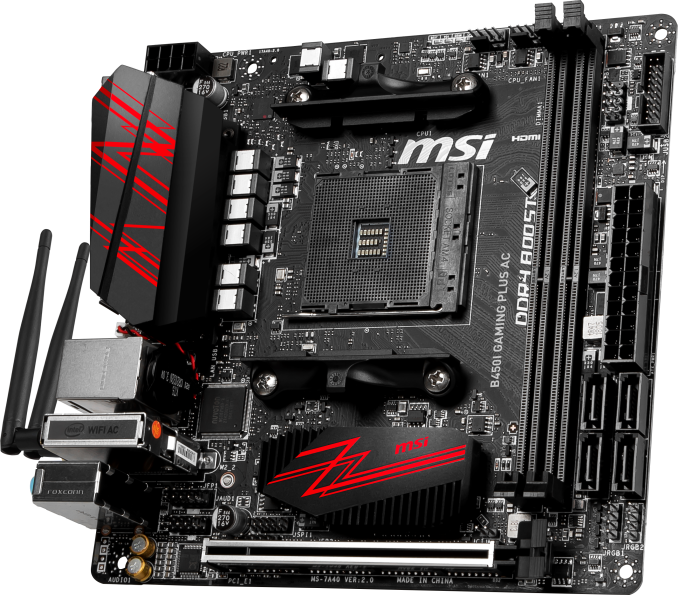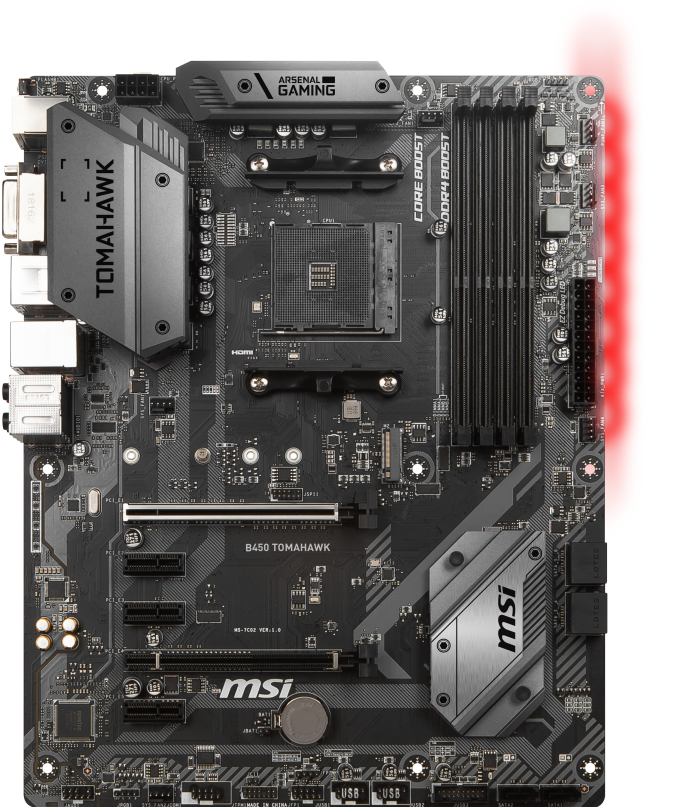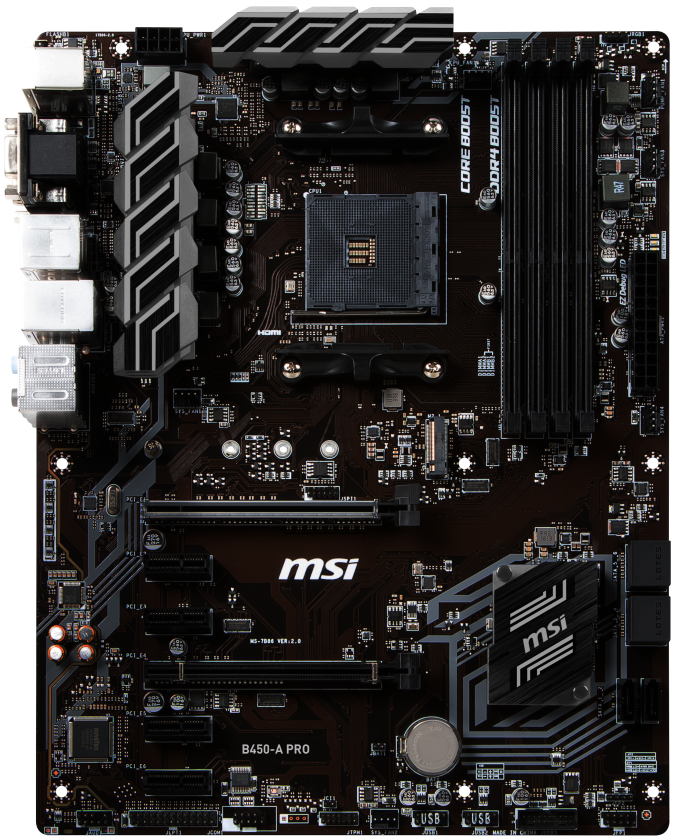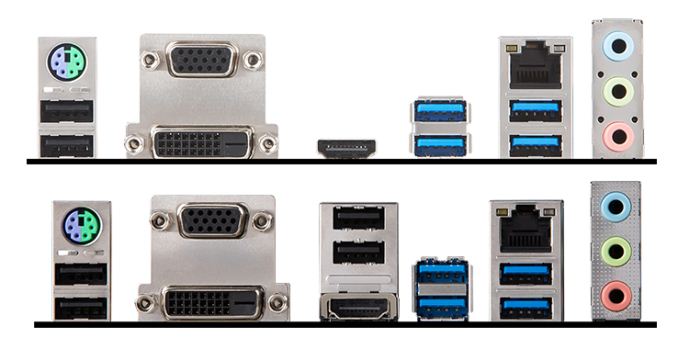
Original Link: https://www.anandtech.com/show/13091/analyzing-b450-for-amd-ryzen-a-quick-look-at-all-the-motherboards
Analyzing B450 for AMD Ryzen: A Quick Look at 25+ Motherboards
by Gavin Bonshor on July 31, 2018 8:00 AM EST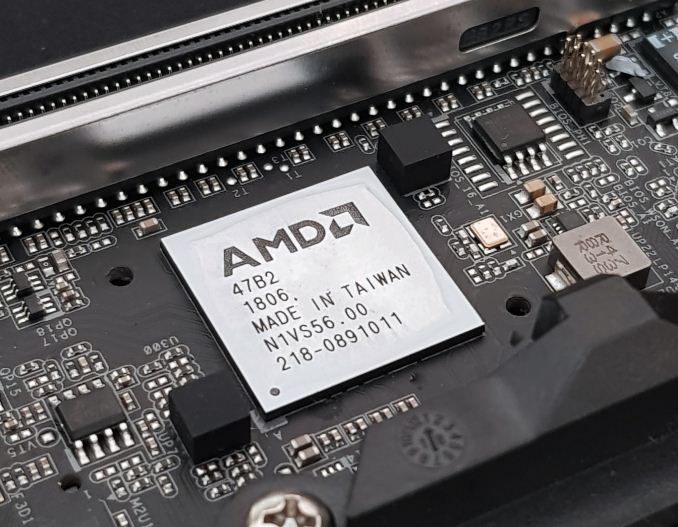
One of the secondary stories from Computex was that AMD and its partners were set to launch a new generation of mid-range chipsets and motherboards with the new lower-power version of the chipset. The B450 chipset is the direct successor to B350, with lower power and features such as Precision Boost 2, XFR2, and StoreMI support. The planned release of 25+ motherboards models is sure to add variety to the market and we take a quick look at all the boards ahead of the launch from vendors such as MSI, ASRock, ASUS, and GIGABYTE.
What's New with the B450 Chipset?
The new B450 chipset launch compliments the release of the Ryzen 2000 series processors, with AMD looking at its current mid-range and high-end parts. The B450 chipset is designed to be a cheaper entry point into the ecosystem, even for users picking up the eight-core Ryzen 2700X ($329) and hex-core Ryzen 2600X ($229) units and going to overclock.
Like the already released X470 Promontory chipset, the B450 chipset is the direct successor to previous first generation B350 chipset. Not much hasn’t changed on the surface in regards to USB connectivity, storage options and PCI lanes, however AMD has added a couple of new technologies to bolster the appeal of the new budget-focused chipset.
| AMD AM4 Chipsets | |||||||||||||
| DDR4 | OC | USB | SATA | PCIe 2.0 |
GPU | XFR2 PB2 |
StoreMI | TDP | RAID SATA |
RAID NVMe |
|||
| 3.1 | 3.0 | 2.0 | |||||||||||
| X470 | 2933 | Y | 2 | 6 | 6 | 6 | 8 | x8/x8 | Y | Y | 4.8W | 0,1,10 | |
| X370 | 2667 | Y | 2 | 6 | 6 | 6 | 8 | x8/x8 | N** | N^ | 6.8W | 0,1,10 | |
| B450 | 2667+ | Y | 2 | 2 | 6 | 6* | 6 | x16 | Y | Y | 4.8W | 0,1,10 | |
| B350 | 2667 | Y | 2 | 2 | 6 | 4 | 6 | x16 | N** | N^ | 6.8W | 0,1,10 | |
| A320 | 2667 | N | 1 | 2 | 6 | 4 | 4 | x16 | N** | N^ | 6.8W | 0,1,10 | - |
| Embedded | |||||||||||||
| X300 | 2667 | Y | 0 | 4 | 0 | 2 | 4 | x8/x8 | N | N | ? | 0,1 | - |
| B300 | 2667 | N | 0 | 4 | 0 | 2 | 4 | x16 | N | N | ? | 0,1 | - |
| A300 | 2667 | N | 0 | 4 | 0 | 2 | 4 | x16 | N | N | ? | 0,1 | - |
*possibly four, double checking with AMD
**Can be possible with BIOS updates, will be motherboard dependant
^ Can be enabled with certain CPUs if a license is purchased
While the specifications on the surface make the B450 seem like a carbon copy of the B350 chipset, as they share native support for the same USB configuration, the same SATA configuration, support for a single M.2 PCIe 3.0 x4/SATA port, and six PCI lanes dedicated to PCIe 2.0 slots. They also both enable support for the same PCIe 3.0 bifurcation, giving a single PCIe 3.0 x16 slot, focusing these systems on a single GPU.
Lower Power and StoreMI For Everyone (on B450 and X470)
As with the jump from the X370 to the X470 chipsets, a primary difference from B350 to B450 come through lower power consumption - the B450 chipset runs a lower powered integrated controller which reduces the idle power draw by just under 2 W, from 6.8 W to 4.8 W.
Another big feature is AMD's StoreMI storage technology which isn’t necessarily an addition to the chipset itself, but enabled through B450. This enables users to unify the various storage in their system to make the best arrangement for the fastest access to data. The StoreMI technology is explained further in our Ryzen 2700X, 2700, 2600X and 2600 processor reviews.
Precision Boost 2: No More Turbo Tables
One of the biggest changes, related to the Ryzen-2000 series, is in how the processor implements its turbo. Up until this point (except the recent APU launch), processors have relied on a step function implementation: the system determines how many threads are loaded, attempts to implement a specific frequency on those cores if possible, and then follows the look-up table relating thread count to frequency. AMD’s goal in Precision Boost 2 is to make this process more dynamic.
This image from AMD is how the feature is being represented: the system will determine how much of the power budget is still available, and turbo as much as possible until it hits one of the limiting factors. These factors can be any of, but not limited to, the following:
- Total chip peak power
- Individual core voltage/frequency response
- Thermal interactions between neighboring cores
- Power delivery limitations to individual cores/groups of cores
- Overall thermal performance
Extended Frequency Range 2 (XFR2): Cooler = Faster, Right?
The following analysis on XFR2 comes from our previous AMD Ryzen 2700X, 2700, 2600X and 2600 review.
For the Ryzen 2000-series, AMD has changed what XFR does. In the previous generation, it was applied on certain processors to allow them to boost above the maximum turbo frequency when the thermal situation was conducive to higher frequencies and higher voltage in low thread-count states. For this generation, it still relates to thermals, however the definition is applied to any core loading: if the CPU is under 60ºC, the processor can boost no matter what the loading is above its Precision Boost 2 frequency (so why not get a better PB2 implementation?). The core still has to be within a suitable voltage/frequency window to retain stability, however.
Both Precision Boost 2 and Extended Frequency Range 2 are supported on B450.
Other AnandTech Ryzen Coverage
- The AMD 2nd Gen Ryzen Deep Dive: 2700X, 2700, 2600X, and 2600 Tested
- The AMD Ryzen 5 2400G and Ryzen 3 2200G APU Review: Marrying Vega and Zen
- The AMD Ryzen 3 1300X and Ryzen 3 1200 CPU Review: Zen on a Budget
- The AMD Ryzen 5 Review: All Ryzen 5 CPUs Tested
- The AMD Zen and Ryzen 7 Review: A Deep Dive on 1800X, 1700X and 1700
- Overclocking The AMD Ryzen APUs: Guide and Results
- Delidding The AMD Ryzen APUs: How To Guide and Results
- Best CPUs for Gaming: Q2 2018
Motherboards in This Overview
- ASRock B450 Gaming K4
- ASRock B450 Gaming ITX/ac
- ASRock B450 Pro4
- ASRock B450M Pro4
- ASRock B450M-HDV
- ASUS Strix B450-F Gaming
- ASUS Strix B450-I Gaming
- ASUS TUF B450-Plus Gaming
- ASUS TUF B450M-Plus Gaming
- ASUS Prime B450-Plus
- ASUS Prime B450M-K
- GIGABYTE B450 Aorus M
- GIGABYTE B450 Aorus Elite
- GIGABYTE B450 Aorus Pro
- GIGABYTE B450 Aorus Pro WiFi
- GIGABYTE B450M DS3H
- MSI B450 Gaming Plus
- MSI B450M Gaming Plus
- MSI B450 Gaming Pro Carbon AC
- MSI B450I Gaming Plus AC
- MSI B450 Tomahawk
- MSI B450M Bazooka
- MSI B450M Bazooka Plus
- MSI B450M Mortar
- MSI B450M Mortar Titanium
- MSI B450-A Pro
- MSI B450M Pro-M2
- MSI B450M Pro-VDH
- Choosing the Right B450 Motherboard
ASRock B450 Gaming K4
Both the B450 Gaming K4 and B450 Gaming ITX/ac feature similar designs with gunmetal grey heatsinks which feature fins to help direct airflow through the channels, which in turn should help dissipate any excess heat. The boards both feature support for ASRock’s Polychrome RGB technology, with the B450 Gaming K4 having customizable LEDs under the chipset heatsink and additional expansion through a single addressable LED header and standard RGB LED header.
From a quick glance, it looks as though the B450 Gaming K4 has a 9-phase power delivery which appears to be operating in a 6+3 configuration - the Gaming K4 has a heatsink covering the entirety of the MOSFETs, compared to the smaller Gaming-ITX model which only covers the CPU section of the power delivery.
The rear panel of the Fatal1ty B450 Gaming K4 consists of a two USB 3.1 10 Gbps ports (Type-A and Type-C), four USB 3.1 5 Gbps ports, two USB 2.0 ports, an HDMI output, a DisplayPort 1.2 output, a D-sub output and a combo keyboard/mouse PS/2 port. The single LAN port is controlled by a Realtek RTL8111H Gigabit networking chip with the three 3.5mm audio jacks being powered by a Realtek ALC892 audio codec.
The ATX sized B450 Gaming K4 has a host of gaming-themed features, AMD 2-way CrossFire multi-graphics card support (x16 + x4) and integrated RGB. The new ASRock B450 models directly replace the currently available B350 offerings and as it stands currently, the B450 Gaming K4 sits at $99.99.
ASRock B450 Gaming ITX/ac
The B450 Gaming K4 uses similar gunmetal grey heatsinks designs as the B450 Gaming K4, which feature fins to help direct airflow through the channels. The board features support for ASRock’s Polychrome RGB technology, however the B450 Gaming-ITX/ac has no onboard LEDs with the RGB capabilities coming through the same pairing of available headers.
Buy ASRock B450 Gaming ITX/ac on Newegg
The B450 Gaming ITX/ac has a single full-length PCIe 3.0 x16 slot featuring ASRock Steel Slot protection, and has a total of four SATA 6 Gbps ports with all of them featuring straight angled connectors. For M.2, the Gaming ITX/ac model features a single PCIe 3.0 x4/SATA slot located on the rear of the PCB.
As is usually the case with Mini-ITX form factor motherboards, the ASRock B450 Gaming ITX/ac has a total of two RAM slots giving a maximum supported capacity of up to 32 GB of DDR4. One of the advantages to Mini-ITX is the length of the tracks between the RAM slots and the CPU socket meaning better memory capabilities is possible, which in this case is shown through DDR4-3466 support, compared to DDR4-3200 for the Gaming K4.
On the smaller form factor Fatal1ty B450 Gaming ITX/ac rear panel is two USB 3.1 10 Gbps ports (Type-A and Type-C), two USB 3.1 5 Gbps ports, two USB 2.0 ports, a HDMI output, a DisplayPort 1.2 output, two antenna ports for the integrated Intel 802.11ac Wi-Fi module and a PS/2 combo port. The five 3.5mm audio jacks and S/PDIF optical output are governed by a high-quality Realtek ALC1220 audio codec, while the LAN port is driven by an Intel I211AT Gigabit networking controller.
Overall, the smaller B450 Gaming ITX/ac compared to the K4 has higher quality integrated controllers and omits any form of built-in RGB. The new ASRock Fatal1ty B450 models directly replace the currently available B350 offerings and as it stands currently, with the B450 Gaming ITX/ac is set to cost $129.99.
ASRock B450 Pro4 and B450M Pro4
The ASRock Professional series drop the gaming-themed stylings the gaming range, with both the B450 Pro4 and B450M Pro4 featuring a subtler black PCB, with a grey contrasting pattern printed on. The Pro4 models are aimed at professional users looking for a solid foundation to build a system without sacrificing quality, but without encumbering budget away on unnecessary componentry and features.
While the primary difference between the B450 Pro4 and B450M Pro4 is form factor, the larger and ATX sized Pro4 model has a full-length PCIe 3.0 x16 slot, a secondary full-length PCIe 2.0 x4 slot and a total of four PCIe 2.0 x1 slots. The smaller B450M Pro4 is of the microATX standard, but also features two full-length slots with the top slot operating at PCIe 3.0 x16 and the bottom one running at PCIe 2.0 x4; a single PCIe 2.0 x1 slot is also present. The similarities don’t just stretch to design, but they look to share identical power deliveries with a 9-phase offering running in a 6+3 configuration; even the power delivery heatsinks are identical, with the chipset heatsink on the B450M Pro4 model being smaller due to size constraints.
Both B450/B450M Pro4 motherboards have a total of four DRAM slots with a supported capacity of up to 64 GB of system memory. Support for up to DDR4-3200 is featured with both models offering support for ECC and non-ECC unbuffered DDR4 memory.
Storage wise, the ATX sized B450 Pro4 has a total of six SATA 6 Gbps ports offering support for RAID 0, 1 and 10 arrays; the smaller microATX B450M Pro4 has a total of four SATA 6 Gbps. The Pro4 pairing also feature two M.2 slots each with the best slot operating at PCIe 3.0 x4, while the second M.2 slot on the ATX B450 Pro4 has support for both SATA and PCIe 3.0 x2 drives. Due to space constraints on the microATX B450M Pro4, the second M.2 slot is located on the rear of the PCB and only supports SATA 6 Gbps SSDs; this slot shares bandwidth with the SATA port number 3 meaning only one can be used at any one time.
On the rear panels. Both the B450 Pro4 and B450M Pro4 share near identical connections with the biggest difference being that the B450 Pro4 has a DisplayPort 1.2 video output, while the B450M Pro4 has a DVI-D instead. Both models feature a single HDMI port and a legacy D-sub output. On the rear panel for both are a single USB 3.1 10 Gbps Type-A port, a single USB 3.1 10 Gbps Type-C port, four USB 3.1 5 Gbps Type-A ports, two USB 2.0 ports, a PS/2 combo port, a single LAN port powered by a Realtek RTL8111H Gigabit controller and three 3.5mm audio jacks which are controlled by a Realtek ALC892 audio codec.
Both B450 and the B450M Pro4 are designed for professional and regular system users, although gaming on either model wouldn’t have any detrimental effect on performance other than the lack of RGB lighting which seems to be the most popular feature on gaming branded boards. The B450 Pro4 is set to retail for around $89.99, with the microATX sized B450M Pro4 coming in at a slightly cheaper $79.99.
ASRock B450M-HDV
The B450M-HDV features an microATX form factor and has a pairing of Realtek controllers to take care of the onboard audio solutions and networking capabilities. The B450M-HDV also represents the base B450 model from ASRock with a few of the bells and whistles associated with ASRock’s other models with the aim to shave as much from the overall cost as possible. The design across the entirety of the board is plain, with little attention to the aesthetic. ASRock takes advantage of as much as it can from what is integrated onto the board chip wise.
In terms of PCIe support, the B450M-HDV has a single full-length PCIe 3.0 x16 slot with a single PCIe 2.0 x1 slot located just above this. This particular microATX board supports up to 32 GB of DDR4-3200 memory. Storage on the B450M-HDV is provided by four SATA 6 Gbps ports with two of them having right-angled connectors, and the remaining two featuring straight angled ports. A single Ultra M.2 slot is also present with support for both PCIe 3.0 x4 and SATA capable SSDs.
The power delivery looks to consist of 7-phases with them being split into a 4+3 configuration. The B450M-HDV is also the only board from the launch models of any brand on the B450 chipset to feature a single 4-pin 12 V ATX power input; a 24-pin ATX motherboard power input is also present. While the power delivery would seem sufficient for general use, the power delivery heatsink looks a little on the bare side and it wouldn’t be advisable to do too much overclocking on this model as VRM temperatures could be a potential problem.
On the rear panel are four USB 3.1 5 Gbps Type-A and two USB 2.0 ports, as well as a PS/2 combo port. The single RJ45 LAN port takes command from a Realtek RTL8111H Gigabit networking controller, while the three 3.5mm audio jacks come provided thanks to a Realtek ALC887 audio codec. The B450M-HDV has support for the Ryzen 5 2400G ($169) and Ryzen 3 2200G ($99) APUs thanks to a trio of video outputs consisting of a D-Sub, a DVI-D and an HDMI port.
The ASRock B450M-HDV represents good value for money with an expected price of $69.99 at launch depending on retailer. The inclusion of a 'good value' Realtek ALC887 audio codec and Realtek RTL8111H Gigabit networking controller shows that users looking to avoid spending extra money on fancy aesthetics and more of the budget on actual sustenance which will have a bigger bearing on actual performance than fancy naming schemes.
ASUS ROG Strix B450-F Gaming
Opening up on the ASUS line-up of B450 motherboards, the ROG Strix B450-F Gaming looks to be one of the most premium rich of all the B450 options at launch. The Strix B450-F is a mid-ranged ATX offering with a host of features including a SupremeFX S1220A audio codec, an Intel I211-AT Gigabit networking controller and an HDMI 2.0b output on the rear panel; this is in addition to a Strix DisplayPort 1.2 output to make use of the Ryzen 2000 series APUs featuring Vega graphics. The Strix B450-F has an integrated RGB LED behind the ROG eye on the rear panel cover, with the capability to expand upon this thanks to two included AURA Sync capable RGB headers.
The general theme of the design comes in a different style to ROG themed boards of the past which were generally red and black, with the B450-F Gaming following its own journey with a black and grey contrasting PCB. The biggest focal point of the design is an extravagant looking chipset heatsink which has a futuristic styled ROG Strix sticker. An alternatively designed sticker with the same futuristic text, but with a subtler design will be available in the box.
Following in line with the majority of B450 motherboards, the Strix B450-F Gaming has support for DDR4-3200 memory, with a maximum capacity of 64 GB across the four available RAM slots. A total of six 4-pin headers make up the cooling options which are divided into two CPU fan headers, three regular chassis headers and one dedicated for an AIO or water cooling pump. A further USB 3.1 5 Gbps and four USB 2.0 ports can be opened up by the use of onboard headers and a clear CMOS jumper is also featured on this board instead of a dedicated button.
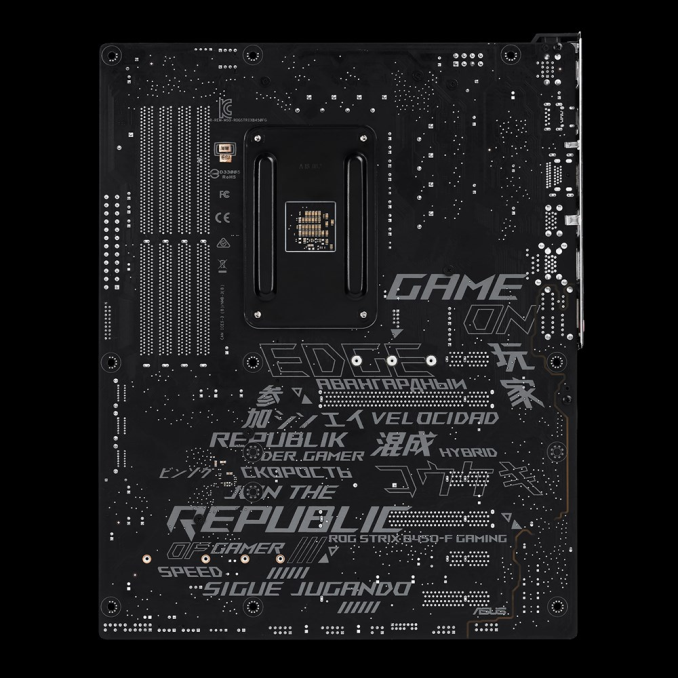
The ROG Strix B450-F Gaming's uniquely styled PCB on the rear
The ROG Strix B450-F Gaming has two full-length PCIe 3.0 x16 slots which when both slots are populated, operate at x8/x4. With the bottom full-length PCIe 2.0 x4 slot being driven directly from the B450 chipset, it’s possible to run AMD 3-way CrossFire multi-graphics configurations on this particular model. Both the PCIe 3.0 x16 slots feature a wave of ASUS’s SafeSlot metal coating designed to provide the slots with extra protection. The B450-F Gaming also features three PCIe 2.0 x1 slots.
Focusing on power options, the ROG Strix B450-F Gaming looks to feature 8-phase digital power delivery most likely consisting of a 6+2 design. An 8-pin ATX 12 V power input is present to deliver power directly to the CPU, whereas a single 24-pin ATX power input is also present to provide auxiliary power to the board and the rest of the controllers. A metallic silver heatsink covers the MOSFETs and looks rather formidable for a mid-ranged motherboard.
The majority of the storage connectivity on the Strix B450-F Gaming comes through six right-angled SATA 6 Gbps ports with four being driven directly from the B450 chipset. The SATA 6 Gbps ports support different RAID arrays including 0, 1 and 10. Also present is a duo of M.2 slots with both having support for PCIe 3.0 x4 M.2 drives, while the top slot which supports both PCIe and SATA drives up to a size of M.2 2280 (22 x 80 mm), the bottom slot only supports PCIe 3.0 x4 drives with a sizing up to M.2 22110 (22 x 110 mm).
On the rear panel, there are USB connections aplenty with two USB 3.1 10 Gbps ports (in blue), four USB 3.1 5 Gbps Type-A ports (in blue) and two USB 2.0 ports. Also present on the rear panel is five 3.5mm audio jacks an optical S/PDIF output which is powered by the ASUS ROG branded Supreme FX S1220A codec; this is further enhanced through the ASUS Sonic Studio III software. A single LAN port is featured controlled by an Intel I211-AT Gigabit network controller, with a PS/2 combo port and a pairing of video outputs consisting of a DisplayPort and HDMI 2.0 output finishing off the rear. One of the biggest aesthetic changes to the rear panel comes through a black I/O shield which is pre-mounted to the board out of the box.
The ASUS ROG Strix B450-F Gaming as the naming scheme would state, is specifically aimed at gamers looking to make use of premium integrated features such as the SupremeFX S1220A audio codec, but without spending $200+ on a more feature-packed X470 motherboard. The major disadvantage with B450 is the lack of NVIDIA SLI multi-graphics support, but the Strix B450-F is as good looking as they come on paper without spending excessively for unnecessary features. The rear of the PCB is a particular visually pleasing point, although most users won't see this aside from installing the board into their chassis of choice. The ROG Strix B450-F Gaming is set to retail for $129.99 which makes this one of the most expensive, but also feature packed B450 boards at launch.
ASUS ROG Strix B450-I Gaming
While the B450-I is the smaller sibling of the Strix B450-F, it packs a mighty punch in feature sets with a host of good quality components usually found on mITX form factor boards over the years from ASUS. The Strix B450-I includes a ROG SupremeFX S1220A audio codec with dual operational amplifiers, an Intel I211-AT Gigabit LAN controller and an Intel 802.11ac Wi-Fi adapter with MIMO capabilities built-in.
Looking closer at the Strix B450-I, the general theme follows that of the Strix B450-F board. The Strix B450-I follows a more subtle and clandestine style primarily due to its size, with a metallic grey heatsink which sits above the rear panel and MOSFETs. The RGB lighting built-in spans across the right-hand side of the board offers a unique and customizable under glow thanks to the ASUS Aura Sync technology which means it can be synchronized up with compatible peripherals and components such as graphics cards. On top of this are a single addressable RGB header and a regular RGB header.
Due to the size limitations on smaller form factor motherboards such as this one, there is only a single full-length PCIe 3.0 x16 slot which is covered in ASUS’s SafeSlot metallic armor coating to protect against slot damage from the heavier load bearing graphics cards.
Focusing on memory support, the smaller form factor has its benefits in this department as the ROG Strix B450-I supports up to DDR4-3600 with a maximum capacity of up to 32 GB of system memory split across two memory slots. Smaller form factor boards from ASUS generally tend to perform well in the memory stakes due to the closer tracks between the CPU socket and the RAM slots themselves, usually giving the memory lower latencies; although the benefits are marginal at best in real-world scenarios, they make quite a difference in situations such as benchmarking and sub-zero overclocking.
Touching more on the power capabilities, the Strix B450-I seems to feature an 8 phase Digi+ power delivery in a 6+2 configuration, with an 8-pin ATX 12 V power input to power the processor. In addition to this is a standard 24-pin ATX power connector featured on the right-hand side of the board.
The ASUS ROG Strix B450-I has a combined total of three 4-pin connectors spread across a dedicated header for a CPU fan, a single chassis fan connector and a specific connector for an AIO CPU cooler pump, or water cooling pump. Like most B450 motherboards, this particular model has a simple clear CMOS jumper instead of a button and has the capability to increase the number of USB ports through internal headers by a further two USB 3.1 5 Gbps and two USB 2.0 ports.
Making up the storage options on the Strix B450-I are four SATA 6 Gbps ports with all four of them being angled straight out of the board; we find two each on either side of the memory slots. The SATA 6 Gbps ports offer support for RAID 0, 1 and 10 arrays. In addition to the available SATA ports is a duo of M.2 slots with both slots accommodating drives up to M.2 2280 (22 x 80 mm), and both supporting the PCIe 3.0 x4 interface. One of the slots is located just above the full-length PCIe 3.0 x16 slot and features an integrated M.2 heatsink which has the futuristic text. The second slot is located on the rear of the PCB and features no cooling options other than available passive cooling from the system its installed into.
The audio is the same ROG SupremeFX S1220A audio codec found on the B450-F but is also supplemented by a pairing of operational amplifiers to further enhance the sound. Due to the size limitations, the SupremeFX S1220A codec only allows a total of three 3.5mm audio jacks on the rear panel, but they do contain an element of LED illuminated goodness; if that’s considered a selling point for an ITX board. In addition to the audio capabilities, the rear panel also has a total of four USB 3.1 5 Gbps Type-A ports and a pairing of USB 3.1 10 Gbps Type-A ports which are distinguished by their red color.
Finishing off the connections on the ROG Strix B450-I is an Intel I211-AT controlled Gigabit LAN port, two slots to attach the two included antennas to capitalize on the built-in 802.11ac MIMO 2T2R capable Wi-Fi module with Bluetooth 4.2 support, and last but most certainly not least, a single HDMI 2.0b capable video output for use with the Ryzen APUs.
It’s clear that the ROG Strix B450-I is a formidable offering featuring the same 8-phase Digi+ power delivery with two more than most ASUS B450 boards at launch, as well as a svelte integrated M.2 heatsink offering some function to users looking to utilize an NVMe capable drive in a small form factored PC, as well as some points in the style stakes too. The B450-I would be more suited to a powerful gamer with a beefy pixel rendering goliath such as an NVIDIA GTX 1080 Ti paired off with a Ryzen 2700X processor and DDR4-3600 memory for a pocket rocket gaming system. The expected retail price is currently unknown as of yet.
ASUS TUF B450-Plus Gaming and
ASUS TUF B450M-Plus Gaming
Back in October last year, I went to an ASUS meeting at the UK HQ to talk about the upcoming Intel Z370 Motherboard launch where I was introduced to the ASUS TUF Z370-Pro Gaming and Z370-Plus Gaming. The TUF branding from ASUS is synonymous with boards such as the ASUS TUF X99 Sabertooth, so when ASUS HQ officials explained to me that the TUF (The Ultimate Force) brand was being re-arranged from a range with rugged looksand a longer than usual five year warranty to a more budget-focused gaming range which sits below the Strix range, it was somewhat nauseating. Nonetheless, ASUS states that they feel this is the best way forward for the brand, along with collaborations with memory and cooling manufacturers to be part of the TUF system.
With the launch of the new B450 chipset, ASUS has let loose two new TUF Gaming branded boards through the full-sized ATX TUF B450-Plus and the smaller TUF B450M-Plus.
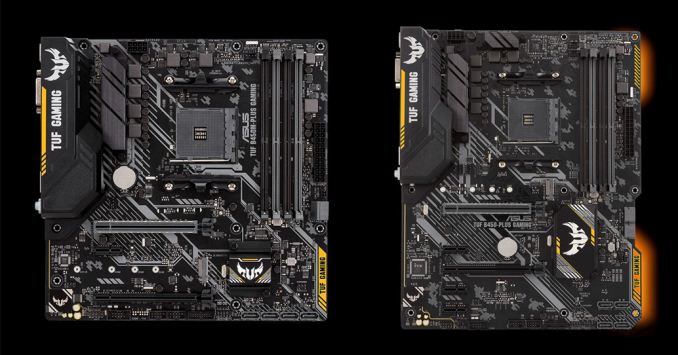
The ASUS TUF B450M-Plus (left) and ASUS TUF B450-Plus (right) motherboards
Aesthetically speaking, both TUF B450 models have a near identical style with a customizable RGB section at the bottom right-hand corner, with both boards having a TUF branded chipset heatsink, dark grey metallic power delivery heatsinks and a rear panel cover which is black. The PCB also has a black and grey contrasting design printed on and the heatsinks have a yellow accented style which falls in line with the new TUF color scheme.
Both the TUF B450-Plus and B450M-Plus have very similar feature sets and component choices, with the main differences between the two coming through the form factor, which then naturally limits the PCIe 3.0 x1 capabilities of the B450M-Plus due to conforming to microATX standards. What both boards do share is two full-length PCIe slots with the top slot operating at PCIe 3.0 x16 and the second full-length slot operating at PCIe 2.0 x4 across both boards. The B450-Plus has a total of three PCIe 2.0 x1 slots, whereas the TUF B450M-Plus has a solitary x1 slot available.
Focusing on the power, ASUS looks to have equipped the same six phase Digi+ power delivery across both models, with the phases operating in 4+2 mode. Both boards have a metallic looking heatsink across the CPU section of the power delivery, while the SoC section does not. Power to the CPU comes from an 8-pin ATX 12 V input and power to the rest of the motherboard and chipset comes through a 24-pin ATX power input.
Both the TUF B450-Plus and B450M-Plus share the same storage options which primarily consists of six SATA ports with both models having four straight angled connectors, and two right-angled connectors emanating from the board. Users looking to make use of RAID storage configurations will be pleased to know both boards can accommodate RAID 0, 1 and 10 arrays. There is also a single PCIe 3.0 x4 M.2 slot featured on both models with support for drives up to a size of M.2 22110 (22 x 110 mm) and allows for both PCIe and SATA varieties of SSD to be used.
With the latest AM4 chipsets offering better memory capabilities out of the box thanks to a wave of firmware updates, both the TUF B450 boards take advantage of DDR4-3200 support from the get-go, with both having four memory slots giving the pairing a total combined memory capacity of up to 64 GB. The TUF boards also support ECC memory, but ASUS does state this support varies depending on the CPU.
In terms of cooling options, the ATX sized TUF B450-Plus has a total of five 4-pin fan headers dotted around the board which are split between one header to the CPU fan, three specifically for case fans and a single header dedicated to an AIO CPU cooler pump. The size limitation strikes the smaller microATX TUF B450M-Plus as only three 4-pin headers are present with a single one for the CPU fan and two for case fans. Both boards can have their USB real estate capabilities pushed beyond what’s on the rear panel with a further two USB 3.1 5 Gbps and four USB 2.0 ports being available through internal USB headers.
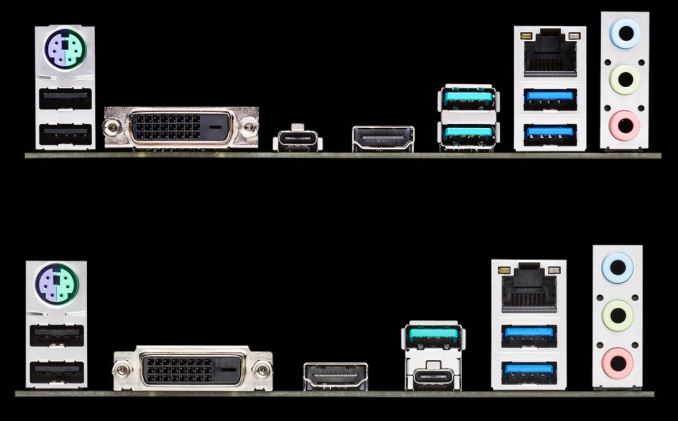
The ASUS TUF B450-Plus rear panel (top) compared to the ASUS TUF B450-M Plus rear panel (bottom)
Directing the attention to the rear panel, both boards have near indistinguishable layouts and connection choice with both boards having a PS/2 keyboard and mouse combo port, a single DVI-D and HDMI port, three 3.5mm audio jacks to make use of the Realtek ALC887-VD2 audio codec. On top of this is a single LAN port which is controlled by a Realtek RTL8111H Gigabit networking chip. The only differences come through the USB connections with the TUF B450-Plus having two USB 3.1 10 Gbps Type-A ports, a single USB 3.1 5 Gbps Type-C, two USB 3.1 5 Gbps Type-A ports and two regular USB 2.0 ports. The smaller ASUS TUF B450M-Plus has a single USB 3.1 10 Gbps Type-A port, a single USB 3.1 5 Gbps Type-C port, two USB 3.1 5 Gbps Type-A ports and two standard USB 2.0 ports.
Both of the TUF B450 Plus models have a unique styling with the black and white contrasting PCB, with yellow accents across the board and there is RGB expansion capability through a single ASUS Aura Sync-enabled RGB header on both for users looking to add their own flair and style. Both boards are near identical in features and with the B450-Plus Gaming set to retail for $119.99 and the smaller B450M-Plus Gaming coming in at a slightly cheaper price of $99.99, both look to offer value to users without scrimping too much on feature set.
ASUS Prime B450 Plus
Although the TUF and Prime brands from ASUS share similar pricing schemes with their low-cost entry-level options, the TUF series is aimed specifically for gamers, whereas the Prime range shifts to a more basic and subtle range of features and aesthetics. The ASUS Prime B450-Plus provides a solid infrastructure to build a solid and good value system upon. The main features of the Prime B450-Plus include a Realtek ALC887-VD2 audio codec with an entry to DDR4-3200 memory support at a low base price.
The aesthetics of the Prime B450-Plus ATX motherboard come through a subtle and clean looking black PCB with grey print which resembles a triangle pattern. The heatsinks across the board feature a classic looking light metallic finish, with a contrasting shade of darker grey to give extra definition. While there are no LEDs embedded into the PCB of the motherboard, a single Aura Sync-enabled RGB header is present to allow for users looking to add at least some element of RGB to their system.
In terms of PCIe, the board has two full-length PCIe slots with the top (grey) slot having a PCIe 3.0 x16 interface, and the second slot (black) taking its bandwidth directly from the B450 chipset, giving it an operational specification of PCIe 2.0 x4. In addition, a further three PCIe 2.0 x1 slots are there to give support for adapter cards such as sound cards and additional networking controllers etc.
The board has a total of four memory slots capable of supporting DDR4-3200, with a maximum capacity across the available slots of up to 64 GB. Both non-ECC and ECC memory are supported, with the latter entirely dependent on the used processor's capability to do so.
Providing power to the motherboard on the right-hand side of the board is a 24-pin ATX power input and between the corners of the MOSFET heatsinks is a single 8-pin ATX 12 V power input to provide power to the CPU. ASUS also advertises a 6-phase Digi+ digital power delivery on the B450-Plus Prime motherboard which is standard across their low-mid range (non-ROG branded) B450 chipset models.
Making up the storage is a total of six SATA 6 Gbps ports with four of them featuring straight angled connectors, whereas the remaining two located below the 24-pin ATX motherboard power input is right-angled. As with all of the B450 motherboards at launch, the SATA 6 Gbps ports support RAID 0, 1 and 10 arrays. A single M.2 slot is located just above the top full-length PCIe 3.0 x16 slot and has support for both SATA and PCIe 3.0 x4 M.2 22110 (22 x 110 mm) SSDs.
In relation to cooling options, the Prime B450-Plus has a total of five 4-pin headers with them being split between three different sections; three for case fans, one dedicated to the CPU fan and one for use with an AIO CPU cooling pump. A clear CMOS jumper is located towards the bottom PCIe 2.0 x1 and there’s capability to expand the featured USB connections by a further two USB 3.1 5 Gbps and four additional USB 2.0 ports thanks to internal headers.
The rear panel on the Prime B450-Plus is a variety of connections including two USB 3.1 10 Gbps Type-A ports, two USB 3.1 5 Gbps Type-A ports, two USB 2.0 ports and a single USB 3.1 5 Gbps Type-C port. Also features is three 3.5mm audio jacks with the onboard audio being powered by the Realtek ALC887-VD2 audio codec, and the single LAN port being handled by a Realtek RTL8111H Gigabit networking controller. To make use of the Ryzen 2000 series APUs is an HDMI and DVI-D output, with a single PS/2 keyboard/mouse combo port finishing off the rear I/O.
While the Prime range is a relatively basic and standard foundation to create a new system, the limitations are on the rest of the components and not the motherboard itself. The Prime B450-Plus looks good for a user not looking for anything too fancy, without paying extra for premium controllers such as the Realtek ALC1220 audio codec; the launch pricing of $109.99 signifies the intent to offer decent quality at a low entry price.
ASUS Prime B450M-K
Rounding off our ASUS B450 launch day overviews is the microATX alternative to the ASUS Prime B450-Plus motherboard, the Prime B450M-K. This smaller form factor motherboard uses a lot of the same components as the ATX sized Prime B450-Plus such as Realtek’s ALC887-VD2 audio codec and RTL8111H Gigabit networking chip, as well as featuring the same level of memory compatibility with DDR4-3200 being supported out of the box.
The style and design run in symmetry with the ATX sized version (Prime B450-Plus) and has a clean and clutter free black PCB, with a grey triangle shaped pattern. The B450M-K omits any integrated RGB backlighting on-board, instead, users can make use of lighting emanating from the PCIe slot and audio trace paths which gives the impression the audio area of the PCB has separation.
Due to the microATX form factor, the Prime B450M-K features a single full-length PCIe 3.0 x16 slot with a further two PCIe 2.0 x1 slots. Memory wise, the board has support for DDR4-3200 with a total capacity of up to 32 GB of system memory over the two provided slots. The Prime B450M-K represents one of the most basic B450 motherboards at launch, but this is reflected in the pricing ASUS gone with for this Prime branded board.
To provide power from the PSU to the motherboard, a 24-pin ATX input can be found on the right-hand side of the board, with an 8-pin ATX 12 V power input dedicated for providing power to the CPU. Aside from the ROG Strix branded B450 pairing, the Prime B450M-K from the images looks as though it has a 6-phase Digi+ power delivery; albeit without any heatsink to help with dissipating heat from the MOSFETs and other phase componentry.
Focusing on the storage options available on the B450M-K, a total of four SATA 6 Gbps ports supporting RAID 0, 1 and 10 arrays is present. All four SATA 6 Gbps ports sit around the edge at the bottom right-hand corner of the board and feature straight angled connectors. In addition to these, is a single PCIe 3.0 x4 and SATA compatible M.2 slot which supports drives up to a sizing of M.2 2280 (22 x 80 mm).
The sizing and budget-friendly nature of the Prime B450M-K allows for only two 4-pin fan headers throughout the board, with one dedicated to the CPU fan and the other to a single case fan; fan splitters could be used to increase the number of support fans, although it would depend on the voltage of the headers which is currently unknown. In addition to the six USB Type-A ports on the rear and additional four USB 2.0 ports can be had from using the internal headers.
On the rear panel, there are a total of two USB 10 Gbps Type-A ports as well as a further four USB 3.1 5 Gbps Type-A ports. Powering the three 3.5mm audio jacks is the Realtek ALC887-VD2 audio codec and the single LAN port is controlled by the Realtek RTL8111H Gigabit networking chip. Unlike every other ASUS B450 motherboard, the Prime B450M-K has a separate PS/2 port for both a keyboard and mouse, with a single DVI-D and VGA output provided to allow use with the AMD Ryzen APUs.
While the ASUS Prime B450M-K is one of the most basic and featureless of all the B450 chipset laden boards at launch, this is reflected in the pricing. The pricing of the B450M-K is currently unknown, but it's expected to cost below $79.99.
GIGABYTE: Changing The Branding with B450
GIGABYTE has gone through a massive transformation over the last couple of years in their motherboard division with the introduction of their Aorus gaming brand, and merging the graphics and mainboard elements in the company under one umbrella. With the arrival of the new B450 chipset, GIGABYTE has revealed a number of new boards to supplement this launch. Instead of following the numbered naming structures previously adopted on the Aorus range, such as gaming 3, the new range will be separated into new names which will not identically replace each previous models, but will help to refine each of the new models such as the Xtreme, Master, Ultra, Pro, Elite etc which will hopefully develop each range to feature their own lineage.
This essentially means with the new naming structure, the AB350 Gaming 3's nearest B450 model and replacement being the B450 Aorus Elite, the AB350M Gaming 3 becoming the B450 Aorus M, the AB350N Gaming WIFI's nearest B450 board being the B450I Aorus Pro WIFI. The AB350M DS3H is being directly replaced by the B450M DS3H. The hope with the change of branding is to coordinate their graphics cards and motherboards naming schemes to tie more into each other from a marketing perspective; simpler naming schemes and branding options mean less confusing when selecting suitable and compatible components.
GIGABYTE B450 Aorus M
Starting with the GIGABYTE B450 Aorus M motherboard, this particular model is an entry level microATX form factor board and is primarily targeted towards gamers looking for a smaller form factor, but with the added benefits of supporting 2-way AMD CrossFire multi-graphics card configurations. The B450 Aorus M could easily be considered a budget focused board considering GIGABYTE's choice of controllers which includes the Realtek ALC892 audio codec which supports 7.1 channel audio and networking which on this board is controlled by a Realtek GbE LAN chip.
Looking at the B450 Aorus M closely, the board aesthetics follow consistently throughout the rest of GIGABYTE’s B450 Aorus range with the biggest differences being form factor and controller selection. The B450 Aorus M features a single PCIe 3.0 x16 full-length slot with a secondary PCIe 2.0 x4 full-length slot giving users the option to run two AMD cards in CrossFire; due to the lack of a PLX chip and with bifuration constraints on the B450 chipset (SLI requires x8 to operate effectively), NVIDIA SLI isn’t supported.
Storage wise, the B450 Aorus M features six SATA 6Gb/s ports with support for RAID 0, 1 and 10 arrays. Sandwiched in between the two full-length PCIe 3.0 slots, is a single PCIe 3.0 x4 M.2 slot with support for both SATA and PCIe drives up to a size of M key 22110 (22 x 110 mm). The M.2 slot also exhibits a thermal guard designed to dissipate heat from an installed M.2 drive which can get rather hot during large file transfers.
The board has four memory slots with support for DDR4-3200 out of the box, with a maximum supported capacity of 64 GB overall. Support is available for both non-ECC and ECC Un-buffered memory modules and as with every B350, B450, X370 and X470 consumer level motherboard, DDR4 with XMP 2.0 memory profiles are supported.
The B450 Aorus M has a single 24-pin ATX power connector to provide power to the motherboard, with an 8-pin ATX 12 V power connector delivering power directly to the CPU. Looking at the power delivery, this model looks to have an multi-phase hybrid digital power delivery which on paper is more than capable of supporting AMD’s top Ryzen 2000 series processor, the Ryzen 7 2700X with an overclock. The power delivery features a single heatsink the closest section to the rear panel, but the top section of phases and VRMs are laid bare.
Dotted around the board are multiple connections including three 4-pin fan headers with one being specifically for the CPU fan and the remaining two being designated as system fan headers. RGB backlighting is supported through a single RGBW LED strip header. The B450 Aorus M lacks an internal clear CMOS button, instead, GIGABYTE has opted towards a jumper. This board also makes use of DualBIOS through two 128 Mbit flash chips which are considered a premium feature and one GIGABYTE likes to implement on a lot of their mid-high range boards.
On the rear panel, there is a variety of connections available with APUs getting some love thanks to the pairing of video outputs; a single DVI-D port and a single HDMI port. In addition to the video outputs, the B450 Aorus M has two USB 3.1 10Gbps Type-A ports, four USB 3.1 5Gbps Type-A ports and two USB 2.0 ports. A further two USB 3.1 5Gbps and four USB 2.0 ports can be made available through the use of the included internal headers. A single PS/2 keyboard and mouse combo port is present with a single LAN port controlled by a Realtek GbE networking chip, with six audio jacks being powered by a Realtek ALC892 audio codec; the codec and capacitors feature PCB separation which is illuminated.
The GIGABYTE B450 Aorus M is aimed at entry level gamers with a launch day price of $84.99 looking for an affordable microATX form factor motherboard with plenty of mid-range features but isn’t looking to spend extra budget on premium controllers and general marketing fluff. The B450 Aorus M on paper makes a good option for users looking at APUs.
GIGABYTE B450 Aorus Elite
Although we currently haven’t received any images and none are currently floating around, little is known about the aesthetics of the B450 Aorus Elite, but we do have a basic list of specifications from GIGABYTE about what can be expected. The B450 Aorus Elite sits as a pure gaming focused offering low specs than the B450 Aorus Pro/Pro WIFI models, but while still conforming to the ATX form factor.
The B450 Aorus Elite is advertised as having the same hybrid digital power delivery as the Aorus M with a single PCIe 3.0 x16 full-length lot, as well as a secondary full-length PCIe 2.0 x4 slot; in addition to these is a pair of PCIe 2.0 x1 slots. GIGABYTE state the board to have two M.2 slots with one featuring an M.2 heatsink, but there’s no indication of how many SATA ports are present. The board is touted to have a GIGABYTE Gaming LAN controller, but one would expect a Realtek Gigabit networking chip to be used, or an Intel 211AT Gigabit controller like the B450 Aorus Pro.
The same can be said about the audio as GIGABYTE has advertised the B450 Aorus Elite to have 8-channel HD audio, which is most likely going to come from a Realtek ALC codec of some kind. Everything is currently pure speculation, but hopefully, we will have more on the B450 Aorus Elite when more details are announced.
GIGABYTE B450 Aorus Pro &
GIGABYTE B450 Aorus Pro WIFI
Both the B450 Aorus Pro and B450 Aorus Pro WIFI models feature near identical PCBs and featuresets, with the main differences being that the WIFI model has an integrated Intel dual-band 802.11ac Wi-Fi module. This also gives the B450 Aorus Pro WIFI the added benefits of Bluetooth 4.2 support.
The B450 Aorus Pro WIFI sits as the premium board from GIGABYTE’s B450 Aorus gaming line-up. The PCB has a black base color with the Aorus falcon in grey towards the PCIe section of the board. Due to GIGABYTE RGB Fusion and implemented RGB LEDs within the power delivery and chipset heatsinks, users have the option to customize the look of their system depending on how they feel; this is also supplemented by additional room for expansion due to an included RGBW LED strip header. Both the power delivery and chipset heatsinks have a metallic grey finish with orange accents which falls in lines with the Aorus branding regime.
Focusing on the PCIe real estate on offer across both models, the Aorus Pro/Pro WIFI feature a full-length PCIe 3.0 x16 slot with a reinforced metal coating to protect the slot from physical damage associated with heavy graphics cards, especially during transit. A further full-length PCIe 2.0 x4 slot sits below which shares bandwidth across both of the PCIe 2.0 full-length slots. This will operate at PCIe 2.0 x2 when either of the PCIe x1 slots is populated, with bottom full-length slot operating at PCIe 2.0 x1. Due to the PCIe configuration on offer, both AMD Quad-GPU CrossFire and dual CrossFire multi graphics cards configurations are supported; NVIDIA SLI multi-card setup aren’t supported on any of GIGABYTE’s B450 motherboard range.
The memory capabilities of both GIGABYTE B450 Aorus Pro and Pro WIFI models include support for DDR4-3200 memory with a total of 64 GB of memory supported across a total of four slots. There is support for both ECC Un-buffered and non-ECC Un-buffered memory with modules supporting XMP memory profiles also being catered for. Both models also feature DualBIOS via two installed 128 Mbit flash chips.
Both models have six SATA ports on offer with the SATA being split into two sections; four right-angled and two straight angled connectors, the latter being located more towards the single 24pin ATX power input for delivering power to the motherboard. The SATA ports across both boards have support for RAID 0, 1 and 10 arrays. In addition to the SATA ports, both the B450 Aorus Pro and Aorus Pro WIFI has a pairing of M.2 slots, with most northernly slot featuring support for PCIe 3.0 x4, and the bottom slot having support for up to PCIe 3.0 x2. In terms of sizing, the top slot has support for drives up to a size of M.2 22110 (22 x 110 mm) and the bottom slot up to M.2 2280 (22 x 80 mm); both slots have support for both PCIe and SATA M.2 SSDs. Both M.2 slots are supplemented with a pair of M.2 thermal guards designed to help dissipate heat from those hot running M.2 SSDs.
A total of five 4-pin fan headers are located around the PCB with one being dedicated for the CPU fan, one dedicated to a water cooling CPU fan, two being devoted as system fan headers and the last being committed to either a system fan or a water cooling pump. In addition to the single RGBW LED strip header, a secondary strip designed for the CPU cooler LED also doubles up as a regular RGB LED strip header giving even more design combinations thanks to the multi-zoned RGB already implemented across both boards. A single 24-pin ATX power input is present to power the motherboard and chipset, with an 8-pin ATX 12 V input dedicated to supplying power to the CPU.
Touching on the power delivery, both models from quick glance look to feature the same hybrid digital VRM as the microATX B450 Aorus M motherboard and keep the configuration consistent across the majority of the mid-range from GIGABYTE. Both B450 Aorus Pro and the Aorus Pro WIFI share the same power delivery heatsink which has a grey metallic finish, with orange accents.
Another prevalent section of both boards is the audio section of the PCB. Both boards consist of a single Realtek ALC1220-VB audio codec, with seven Nichicon Chemicon audio capacitors and four Hi-Fi grade WIMI FKP2 audio capacitors. There is also an element of PCB separation present which is signified by an LED track along the edge of the audio area.
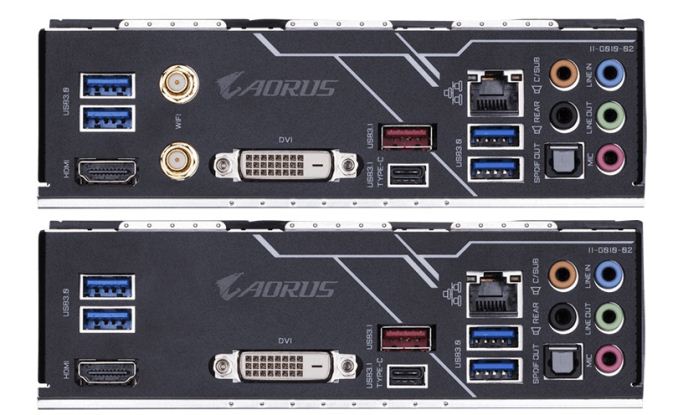
B450 Aorus Pro WIFI rear panel at the top, B450 Aorus Pro at the bottom.
On the rear panels of both boards, the only difference between the B450 Aorus Pro and Aorus Pro WIFI is the WIFI model has adapters present to install the Intel dual-band 802.11ac WiFi, which also includes Bluetooth 4.2 connectivity. The USB connectivity consists of four USB 3.1 5Gbps ports, with two USB 3.1 10 Gbps ports consisting of both a Type-A and a Type-C port; the USB 3.1 10 Gbps ports can be distinguished easily as the ports are colored red. Also included is a single LAN port controlled by an Intel I211-AT Gigabit networking chip, with six 3.5mm audio jacks and a single S/PDIF optical output being driven by the newer Realtek ALC1220-VB audio codec. Finishing off the rear panel on both these B450 Aorus Pro motherboards is a pairing of video outputs; a single HDMI and DVI-D output.
It’s apparent that both these boards are targeted at gamers looking for more premium features from a motherboard such as quality onboard audio and Gigabit networking capabilities but without breaking into the realms of high-end pricing. The B450 Aorus Pro WIFI going one step further and offering 802.11ac Wi-Fi and Bluetooth 4.2 connectivity on top for a stonking price of $119.99. The price for the non-WIFI version of the B450 Aorus Pro hasn't been revealed as of yet, but is expected to be $10-$15 cheaper.
GIGABYTE B450M DS3H
The last of GIGABYTE’s launch day motherboards comes via the B450M DS3H which hails from the Ultra Durable range. With the shift here from gaming to a more subtle theme, the styling choices opted here by GIGABYTE come across as less ‘in your face’ without RGB LEDs built into the heatsinks, but users looking to make use of rainbow-colored RGB can do so through a single RGB LED strip header.
Without a lot of the bells and whistles of the B450 Aorus motherboards, what the B450M DS3H does focus on is providing value without sacrificing too much on the overall quality. The general controller choice does put this board in the lower range of AM4 boards available, but the Realtek ALC887 audio codec still does a decent job of providing onboard audio. With a Realtek GbE LAN controller present also, the DS3H is admirable for users on a strict budget, but who also require a smaller microATX form factor.
The main bulk of the board's aesthetic prowess come from the PCB, which features a black base with a grey striped circuit-like pattern emanating from the corners of the board towards the socket. This entry-level offering has two full-length PCIe slots; the top slot is PCIe 3.0 x16 while the bottom slot is PCIe 2.0 x4. Sitting in between the two full-length slots is a single PCIe 2.0 x1 slot. Thanks to the two full-length slots, this means AMD CrossFire multi-graphics card configurations are supported, although it should be noted NVIDIA SLI is not supported across the B450 chipset; this is due to a limitation of PCI bandwidth.
Like all of GIGABYTE’s launch day range of B450 motherboards, the B450M DS3H has four memory slots capable of supporting DDR4-3200 memory. This means that a total of 64 GB of system memory can be installed with both ECC and non-ECC Un-buffered memory types being supported. There is also support for DDR4 memory with XMP profiles built-in.
Storage wise, the main bulk is made of from four SATA ports. These ports all feature straight angled slots, which is a pure cost-cutting measure and a consequence of the board's entry-level pedigree. The SATA ports also support RAID 0, 1 and 10 arrays. Also present is a single PCIe 3.0 x4/SATA M.2 slot with support for up to M.2 22110 (22 x 110 mm) SSDs.
In terms of power delivery, the B450M DS3H looks to sport a seemingly simple, but ample, 4+3 hybrid digital design, with a very small and lightweight looking heatsink across the CPU section of the VRM; this leaves the SoC area at the mercy of the system's passive cooling capabilities. Not so much an issue when using a discrete graphics card but could cause potential heat issues if a user intends to use one of the Ryzen 2000 series APUs and overclock them for better performance.
The rear panel on the B450M DS3H microATX motherboard consists of a fairly basic selection of ports and connections including four USB 3.1 5 Gbps ports and four additional USB 2.0 Type-A ports. Also included is a PS/2 combo port, as well as a single LAN port controlled by a Realtek GbE networking chip. The three 3.5mm audio jacks making up the onboard audio are powered by the Realtek ALC887 audio codec. Finishing off the rear panel is a pairing of video outputs which consist of a DVI-D, and HDMI 2.0 port which makes this board suitable for a low-end and entry-level gaming system when paired up with an APU.
The crux of the GIGABYTE B450M DS3H comes in the way of value ($69.99), but without sacrificing core features which are used frequently on most home systems. From the Realtek ALC887 which is a more budget-friendly audio codec opposed to say the ALC1220, to the use a cheaper Realtek GbE networking chip opposed to say the Intel I211-AT featured on their own B450 Aorus Pro/Aorus Pro WIFI models; it gives the B450M DS3H more function and value over style, over the top aesthetics and unnessacary cost spiking componentry.
MSI B450 Gaming Plus and
MSI B450M Gaming Plus
MSI has decided to go one step further than competing vendors launching a minimum of a dozen B450 boards, with a mixture of gaming branded ATX, microATX and Mini-ITX offerings, as well as some more subtle looking models from their budget-friendly Arsenal range. First up is the B450 and B450M Gaming Plus models which aside from sharing similar aesthetics and feature set, the B450 Gaming Plus is full sized ATX, whereas the B450M Gaming Plus conforms to the slightly smaller microATX form factor.
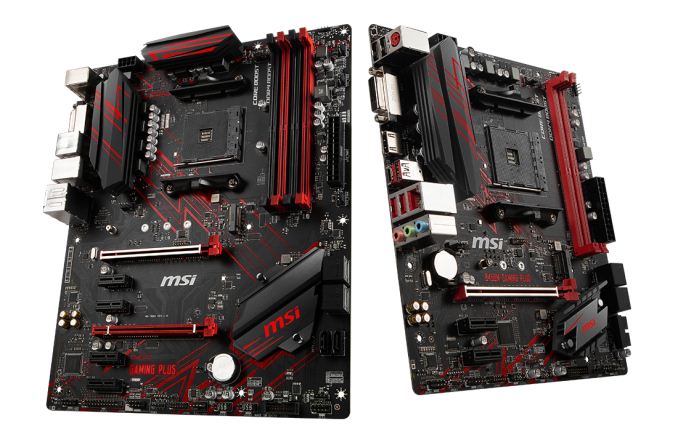
MSI B450 Gaming Plus (left) and MSI B450M Gaming Plus (right)
The general theme of the MSI Gaming branding since the introduction back in 2013 has always been red and black, with both these Gaming branded models conforming to that theme. The heatsinks feature a black metallic sheen with red accents which has been carried over and has been printed onto the jet-black PCB. Neither the B450 or B450M Gaming Plus mentions RGB backlighting, but both boards have two 5050 RGB headers built in.
Starting with the ATX variant, the B450 Gaming Plus has two full-length PCIe slots with the top slot having a PCIe 3.0 x16 interface, and the bottom slot running at PCIe 2.0 x4. Also present is a total of four PCIe 2.0 x1 slots. The B450M Gaming Plus has a single full-length PCIe 3.0 x16 slot and is complemented by a pairing of PCIe 2.0 x1 slots. Both boards use MSI’s Steel Armor on the top full-length PCIe 3.0 x16 slot.
While both boards have support for DDR4-3466 right from the get-go, the B450 Gaming Plus has a total of four RAM slots giving a maximum supported capacity of 64 GB, whereas the B450M Gaming Plus has two slots allowing for a total capacity of up to 32 GB of system memory.
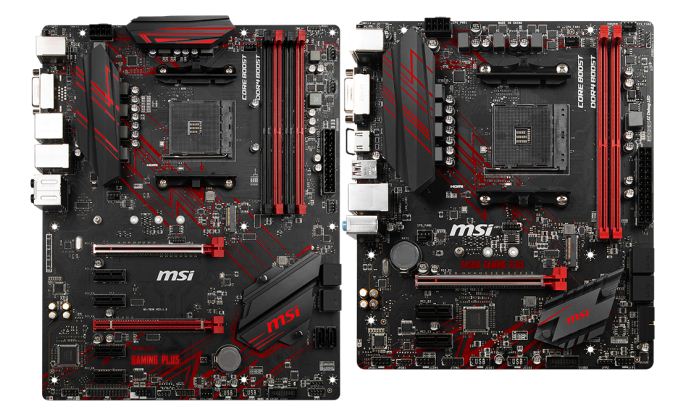
MSI B450 Gaming Plus (left) and MSI B450M Gaming Plus (right)
While both boards have a single M.2 slot, the ATX version supports PCIe 3.0 x4/SATA drives up to a maximum size of M.2 22110 (22 x 110 mm), and the microATX B450M Gaming Plus having room for up to M.2 2280 (22 x 80 mm); this is a side effect of having a smaller form factor. The full-sized version has a total of six SATA ports with four featuring right-angled connectors, with the other two sporting straight angled ports. The B450M has a total of four right-angled SATA 6 Gbps ports, with both boards offering the capability for RAID 0, 1 and 10 arrays.
Providing power to both the B450/B450M Gaming Plus is a 24-pin ATX power connector, while the CPU gets an 8-pin ATX 12 V input. From a quick glance the MSI B450M Gaming Plus looks like it has a 4+3 phase configuration, with the ATX sized model having a 4+2 power delivery. The B450 Gaming Plus has a heatsink covering the entirety of the power delivery, whereas the B450M’s heatsink covers the CPU area, leaving the SoC MOSFETs to be passively cooled by whatever method of system cooling is available.
The B450 Gaming Plus has a total of six 4-pin fan connectors with four being set aside for case fans, a single connector for the CPU fan and a dedicated header for water pumps. The B450M Gaming Plus has a three in total with two being dedicated to case fans and one specifically for the CPU fan. Both models have the capability to expand on USB ports, with the B450M Gaming Plus having a total of four internal headers which allows for an additional four USB 3.1 5 Gbps ports and four USB 2.0 ports. The ATX B450 Gaming Plus has the option to add an additional four USB 3.1 5 Gbps ports and two USB 2.0 ports through its internal headers.
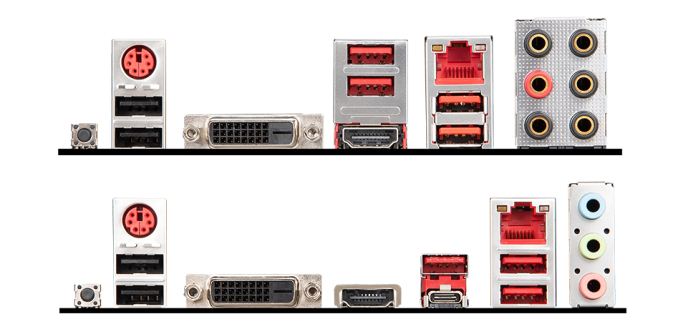
MSI B450 Gaming Plus (top) and MSI B450M Gaming Plus (bottom) rear panels
The rear panels on both boards look strikingly similar with only a few minor differences. The B450 Gaming Plus has two USB 3.1 10 Gbps Type-A ports, with two USB 3.1 5 Gbps Type-A ports as well as two USB 2.0 ports; both models also feature a Clear CMOS button and a PS/2 keyboard and mouse combo port. The B450 Gaming Plus does have a slightly beefier audio with the six 3.5mm audio jacks being powered by a Realtek ALC892 audio codec, whereas the B450M makes do with three 3.5mm jacks controlled by a slightly lower grade Realtek ALC887 codec. The single LAN port on both boards is driven by the Realtek 8111H Gigabit LAN controller and both boards have support for the Ryzen and Vega APUs with HDMI and DVI-D outputs.
While MSI has limited pricing pre-launch, the B450 Gaming Plus looks to cost around $109.99 at launch which would represent relatively modest value for money. The B450M Gaming Plus should by rights come in at around $99.99, but once official pricing is confirmed on the smaller microATX model, we will update.
MSI B450 Gaming Pro Carbon AC
The MSI B450 Gaming Pro Carbon AC sits as MSI’s premier and flagship B450 chipset motherboard and has a strong focus on gaming but moves away from the conventional MSI Gaming red and black theme. The B450 Gaming Pro Carbon AC also uses a variety of premium controllers and chips including the Realtek ALC1220 audio codec, an Intel 9260 dual-band 802.11ac 2T2R Wi-Fi adapter and an Intel I211-AT Gigabit LAN networking chip.
As mentioned, the B450 Gaming Pro Carbon AC moves away from the traditional gaming theme usually seen from MSI, and instead the carbon namesake features an all-black PCB with the bottom left quadrant having a grey lined pattern rising towards the heatsinks and passed the PCIe slots. Both the power delivery and chipset heatsink have a definitive carbon themed styling which blends in with the rest of the board to create a stylish look. The board also has two dedicated RGB zones with the first emanating from the right and side behind the 24-pin ATX power connector, with the second coming from the chipset heatsink. To expand on this, MSI has included a total of three RGB headers with two having support for 5050 RGB LED strips with a maximum power of 12 V, and the last supporting addressable RGB strips up to a power of 5 V.
The board conforms to the standard ATX form factor and has a full-length PCIe 3.0 x16 slot, a full-length PCIe 2.0 x4 slot and three PCIe 2.0 1x slots. The B450 Gaming Pro Carbon AC has a total of four memory slots supporting up to DDR4-3466 with a total of 64 GB system memory supported. A total of six SATA right angled ports and two M.2 slots with one offering PCIe 3.0 x4/SATA support, and the other allowing for just PCIe 2.0 x4 supported drives.
On the rear panel, the B450 Gaming Pro Carbon AC has one USB 3.1 10 Gbps Type-C, one USB 3.1 10 Gbps Type-A, two USB 3.1 5 Gbps Type-A and two USB 2.0 ports. Delivering audio through the six 3.5mm audio jacks and S/PDIF optical output is the Realtek ALC1220 audio codec, with the single LAN port taking direction from an Intel I211-AT Gigabit chip and the Wi-Fi featuring Wave 2 2T2R capability due to the Intel 9260 Wi-Fi module. Finishing off the rear panel is a clear CMOS switch and a P/S2 keyboard and mouse combo port.
While none of the pricing on MSI B450 models has been announced prior to launch, the B450 Gaming Pro Carbon AC is expected to retail for around $149.99.
MSI B450I Gaming Plus AC
The MSI B450I Gaming Plus AC is an Mini-ITX motherboard from MSI’s Gaming range and just like the bigger sized ATX B450 Gaming Plus it shares a similar feature set in terms of controllers and available connections. The main differences aside from the form factor come from the inclusion of an Intel Dual-Band Wireless-AC 3168 Wi-Fi module.
The limitation of Mini-ITX means the B450I Gaming Plus AC has a single full-length PCIe 3.0 x16 slot, with storage options provided by the B450 chipset via four SATA ports; all of the SATA ports feature straight angled connectors which are located just below the 24-pin ATX motherboard power input. Also included is a single M.2 slot capable of supporting PCIe 3.0 x4 or SATA drive up to a size of M.2 2280 (22 x 80 mm). Providing power to the CPU is an 8-pin ATX 12 V input with the B450I Gaming Plus AC seemingly sporting an 8-phase power delivery running in a 6+2 configuration.
Aesthetically speaking, the B450I Gaming Plus AC has an all-black PCB with heatsinks which follows the red and black MSI Gaming theme; the red pattern on both the black power delivery and chipset heatsink resembles a lightning bolt. Looking at memory support, the board has two slots capable of supporting DDR4-3466 with a maximum of 32 GB of memory allowed. The MSI B450I Gaming Plus AC has support for both non-ECC and ECC DDR4 memory, although installed ECC memory will operate in non-ECC mode.
On the rear panel, the B450I Gaming Plus AC has a total of six USB Type-A ports split between four USB 3.1 5 Gbps and two USB 2.0 ports; this board omits any USB 3.1 10 Gbps ports at all and lacks any Type-C connectivity. A single PS/2 keyboard and mouse combo port is present, with the Intel 3168 802.11ac Wi-Fi adapter commanding some space for the two included antennae’s to be installed. Finishing off the rear panel is a pairing of video outputs, an HDMI and DisplayPort, with the three 3.5mm audio jacks being provided by the budget-friendly Realtek ALC887 audio codec and the single LAN port being controlled by the Realtek 8111H Gigabit LAN controller.
MSI has clearly gone the more wallet-friendly approach with the B450I Gaming Plus AC with a host of relatively affordable controllers and offering a smaller form factor Mini-ITX gaming themed alternative. Users looking to customize the look of their system will be pleased to know that MSI has included two 5050 RGB LED strip headers but does lack any integrated RGB capabilities under the heatsinks. The launch price of $119.99 is set to make the ITX AM4 market competitive.
MSI B450 Tomahawk
The MSI B450M Tomahawk is a direct successor to the B350 Tomahawk we previously reviewed, but with a few visual tweaks and the introduction of RGB LED lighting to the mix to give it a more ‘popular’ reach to those looking to customize their system to fit their components and mood. The B450 Tomahawk sports the same Realtek ALC892 audio codec and the same Realtek 8111H Gigabit LAN controller as the B350 model, and on paper, look very similar.
The main differences come through a new PCIe layout consisting of a full-length PCIe 3.0 x16 slot featuring MSI Steel Armor, with a second full-length slot running at PCIe 2.0 x4 and a trio of PCIe 2.0 x1 ports; these replace the legacy PCI slots featured on the previous B350 Tomahawk. One of the advantages of the B450 chipset over B350 is the memory speeds supported, more specifically due to the refined firmware possessed by the B450 Tomahawk, which allows support for DDR4-3466 with a total of 64 GB of system memory supported over the four available slots. The use of both ECC and non-ECC memory is permitted, although the ECC memory will run in non-ECC mode. The main visual difference is the B450 comes with new but svelte looking heatsinks and the power delivery heatsink has the MSI Arsenal Gaming logo to signify the entry-level gaming range this board represents. MSI also seem to have kept the same 6-phase power delivery running in the same 4+2 configuration as the previous B350 Tomahawk.
Storage wise, the B450 Tomahawk has a total of six SATA ports with four featuring right-angled connectors and two having a straight angled design; RAID 0, 1 and 10 arrays are supported. A Single M.2 slot capable of supporting PCIe 3.0 x4 and SATA drives up to a size of M.2 22110 (22 x 110 mm).
On the rear panel, the B450 Tomahawk includes a BIOS Flashback+ button with two USB 3.1 5 Gbps Type-A ports, two USB 2.0 ports and a USB 3.1 10 Gbps Type-A and Type-C port. Also included is a PS/2 keyboard and mouse combo port, six 3.5mm audio jacks powered by a Realtek ALC892 audio codec, a single LAN port controlled by a Realtek 8111H Gigabit networking chip, and two video outputs consisting of an HDMI 1.4 port and a DVI-D port.
While the B450 Tomahawk offers improved memory speeds, classier heatsinks and a small customizable RGB LED strip in the top right corner of the board, the price is likely to reflect this with a touted price of $109.99 at launch; around $20 more than the B350 Tomahawk. Whether or not the new refreshed Tomahawk matches specification and visual aspirations of users, the extra integrated RGB lighting and new style MSI Arsenal Gaming heatsinks on the B450 chipset come at a more expensive premium.
MSI B450M Bazooka and
MSI B450M Bazooka Plus
The B450M Bazooka and B450M Bazooka Plus are a pair of microATX motherboards from MSI’s entry-level Arsenal Gaming range. Both models share the same PCIe configuration and layout with a single full-length PCIe 3.0 x16 slot and two PCIe 2.0 x1 slots. Both boards share the same pairing of onboard audio and network controllers with the Realtek ALC892 8-channel audio codec and Realtek 8111H Gigabit LAN controller both being featured.
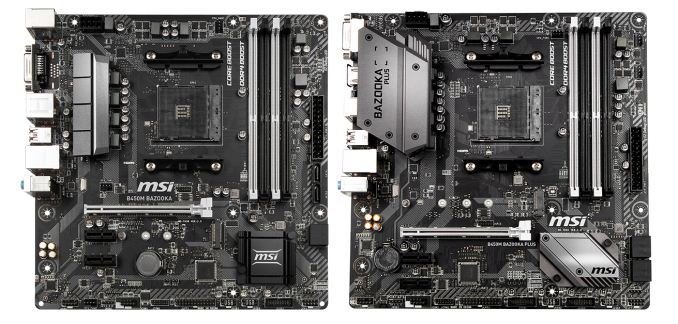
MSI B450M Bazooka (left) and MSI B450M Bazooka Plus (right) microATX motherboards
The visuals are dominated by a black PCB with an industrial looking grey pattern printed on, with the main aesthetic differences between the two boards coming in the way of the heatsinks; the B450M Bazooka Plus has a bigger power delivery heatsink and has a light metallic grey look. The B450M Bazooka has a more basic looking set of heatsinks. Both models look to have a 6-phase power delivery operating in a 4+2 configuration.
While the B450M Bazooka Plus looks to be the more premium of the two microATX offerings, it has support for DDR4-3333 whereas strangely the B450M Bazooka has the ability to handle faster memory out of the box, with DDR4-3466 supported. Both models have a total of four memory slots meaning up to a maximum of 64 GB of system memory can be installed.
The options on both boards for storage are identical with both boards having four SATA 6 Gbps ports and a single PCIe 3.0 x4/SATA M.2 slot which allows drives up to a size of M.2 22110 (22 x 110 mm). The B450M Bazooka has two right-angled SATA ports with having straight angled connectors, while the B450M Bazooka Plus features four right-angled connectors.
Another subtle difference is the B450M Bazooka Plus adds another USB 3.1 5 Gbps header giving the capability to add up to four ports, whereas the B450M Bazooka has a single USB 3.1 5 Gbps header. Both boards can support an additional four USB 2.0 ports thanks to a pairing of USB 2.0 headers. For users looking to add extra RGB LED lighting in addition to the LED lighting onboard, the B450M Bazooka has a single 5050 RGB header, while the B450M Bazooka Plus has two.
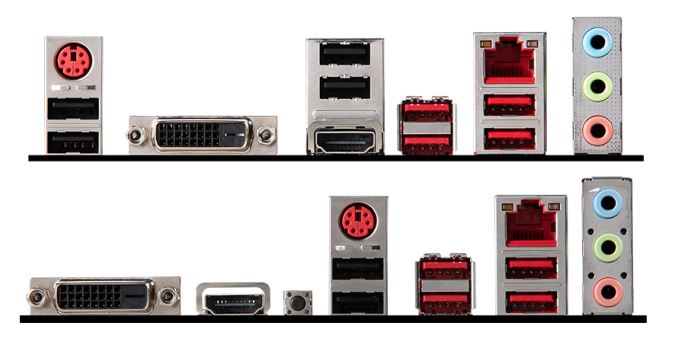
MSI B450M Bazooka (top) and MSI B450M Bazooka Plus (bottom) rear panels
On the rear panel, both boards have four USB 3.1 5 Gbps ports, two USB 2.0 ports, an HDMI 1.4 output, a DVI-D output, three 3.5mm audio jacks due to the Realtek ALC892 audio codec, a single LAN port controlled by the Realtek 8111H Gigabit networking chip and a PS/2 combo port. The B450M Bazooka Plus has the added benefits of a BIOS Flashback+ button.
Both boards aim to win users looking to build a smaller budget gaming system, but without sacrificing on memory capacity and PCIe 2.0 x1 support by going for a small form factor such as Mini-ITX. The B450M Bazooka has better memory support on paper, while the B450 Bazooka Plus has better-styled heatsinks and increased RGB capabilities through a pairing of 5050 RGB headers. No pricing is currently available for the B450M Bazooka Plus, but the regular B450M Bazooka is set to retail for $84.99 at launch.
MSI B450M Mortar and
MSI B450M Mortar Titanium
Like the MSI B450M Bazooka boards, the MSI B450M Mortar and the B450M Mortar Titanium are a part of the MSI Arsenal Gaming collection with the focus being on offering gamers a lower cost alternative and starting point for an e-Sports based gaming system. Unlike the B450M Bazooka and Bazooka Plus models, the only differences between both the B450M Mortar models come in the aesthetics; the B450M Mortar Titanium has a classy silvery PCB and pairing of heatsinks which gives it a unique look. Both boards also have RGB LEDs implemented underneath right-hand side of the board with the option add an additional two 5050 RGB LED strips.
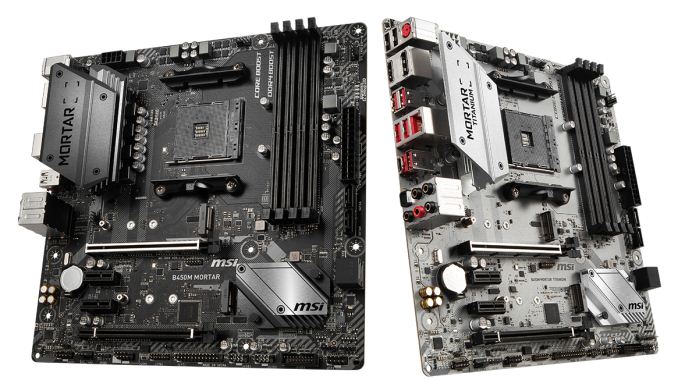
The MSI B450 Mortar (left) and B450 Mortar Titanium (right) motherboards
The B450M Mortar/Mortar Titanium are both microATX form factor, with support for AMD 2-way CrossFire multi-graphics card configurations. The PCIe on the boards consist of a full-length PCIe 3.0 x16 slot with MSI’s Steel Armor slot reinforcement, and a second full-length PCIe 2.0 x4 slot; also included is two PCIe 2.0 x1 slots. Storage wise both models have four SATA right angled ports and two M.2 slots with both slots supporting M.2 2280 (22 x 80 mm) drives, but only one of the slots offering full PCIe 3.0 x4 support. The second slot has support for PCIe 2.0 x4, with both M.2 slots supporting SATA drives too.
Power delivery wise, the B450 Mortar/Mortar Titanium looks to have seven phases running in a 4+3 configuration. Power to the CPU is provided by an 8-pin ATX 12 V power input while the motherboard takes power from a regular 24-pin ATX connector.
Up to DDR4-3466 memory is supported with a total of four memory slots offering a maximum system memory capacity of up to 64 GB. The boards also have a total of four 4-pin fan connectors with one being dedicated to the CPU and the rest set aside as system fan headers.
Both the B450M Mortar and B450M Mortar Titanium share identical rear panels with a two USB 3.1 10 Gbps ports (Type-A and Type-C), four USB 3.1 5 Gbps Type-A ports and two USB 2.0 ports. A pairing of video outputs with support for the Ryzen and Zen based APUs include an HDMI 1.4 port and a DisplayPort. A BIOS Flashback+ button is also included, with a PS/2 combo port, five 3.5mm audio jacks and a S/PDIF optical output and single RJ45 LAN port.
The B450M Mortar offers decent quality controllers and it’s expected that these will cost slightly more than the other microATX B450 Bazooka/Bazooka Plus pairing, but with support for 2-way CrossFire multi-graphics configurations, the B450M Mortar and B450M Mortar Titanium could comfortably be the foundations of a powerful microATX gaming system.
MSI B450-A Pro
MSI’s Pro series of motherboards are designed with professionals in mind, without sacrificing in performance, quality and offers a blend of modest and classic aesthetics. MSI has announced three Pro series boards for the AMD B450 chipset launch, the ATX sized B450-A Pro and a pair of microATX options, the B450M Pro-M2 and B450M Pro-VDH.
Starting with the MSI B450-A Pro motherboard, the design is pretty simplistic with plenty of PCIe connectivity available. MSI markets this particular model as being optimized and suitable for cryptocurrency mining and has a full-length PCIe 3.0 x16 slot, a full-length PCIe 2.0 x4 slot and a total of four PCIe 2.0 x1 slots. Up to DDR4-3466 memory is supported with a supported maximum of up to 64 GB can be installed across the four RAM slots. Both the use of non-ECC and ECC memory is permitted, although installed ECC memory will operate in non-ECC mode.
The B450-A Pro has a total of six SATA 6 Gbps which support RAID 0, 1 and 10 arrays. A single M.2 slot is present with support for drives up to M.2 22110 (22 x 110 mm) and has support for both PCIe 3.0 x4 and SATA capable devices; using this slot disables two SATA ports.
Stylistically, the B450-A Pro has a black PCB with dark grey metallic heatsinks across the power delivery and chipset. The board looks to be running a 6-phase power delivery running in a 4+2 configuration. A single 8-pin ATX 12 V CPU input and 24-pin ATX motherboard input are there to provide power to the board.
On the rear panel the B450-A Pro has two USB 3.1 10 Gbps Type-A ports, two USB 3.1 5 Gbps Type-A ports and two USB 2.0 ports. Also featured is a BIOS Flashback+ button, with a PS/2 keyboard and mouse port. Natively supporting the Ryzen APUs, the board makes use of a single HDMI 1.4 port, a DisplayPort and a legacy VGA port. The RJ45 LAN port is powered by a Realtek 8111H Gigabit controller and the six 3.5mm audio jacks take orders from the Realtek ALC892 audio codec.
With MSI focusing on a mixture of subtle aesthetics, good quality componentry and with cryptocurrency mining support, there isn’t a lot of bells and whistles when compared to the Gaming Series models, but what is on offer is more than enough for professional users. The MSI B450-A Pro is expected retail for $89.99 which makes this one of the most cost-effective full-sized ATX models without Gaming branding and fancy gaming themed software factored in.
MSI B450M Pro-M2 and B450M Pro-VDH
Last up from MSI is a pair of microATX motherboards from the Pro series of motherboards, the B450M Pro-M2 and B450M Pro-VDH. Both models share the same black PCB with brownish traces and tracks, while the B450M Pro-VDH makes use of a heatsink on the CPU section of the power delivery, whereas the B450M Pro-M2 omits power delivery heatsinks completely. Both have a square black metallic chipset heatsink with a fin array.
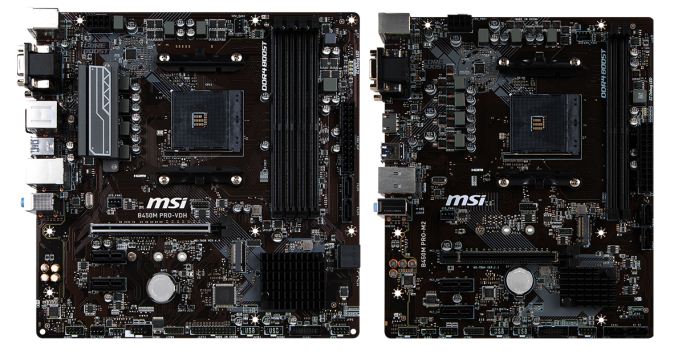
MSI B450M Pro-VDH (left) and MSI B450M Pro-M2 (right)
Both models have a full-length PCIe 3.0 x16 slot with both featuring metal reinforcement; the B450M Pro-VDH having the most predominant looking of the two. Also included on both is a pair of PCIe 2.0 x1 slots for expansion cards. The Pro series microATX pairing have four RAM slots supporting up to DDR4-3466 memory and have the ability to support up to 64 GB. ECC and non-ECC modules are both supported, albeit with installed ECC memory operating in non-ECC mode.
Storage wise, both boards have a total of four SATA 6 Gbps ports with the ports on the B450M Pro-M2 all featuring straight angled connectors, and the B450M Pro-VDH having two right-angled and two straight angled connectors. Both models have a single M.2 slot capable of supporting both PCIe 3.0 x4 and SATA M.2 2280 (22 x 80 mm) SSDs.
While both virtually identical in terms of overall specifications, the main difference comes on the rear panel. Both feature four USB 3.1 5 Gbps Type-A ports and two USB 2.0 ports; the B450M Pro-VDH has an additional two USB 2.0 ports giving it a total of four. Both boards have DVI-D and HDMI 1.4 video outputs, as well as a PS/2 keyboard and mouse combo port. The three 3.5 mm audio jacks on the B450M Pro-M2 is provided thanks to a Realtek ALC887 audio codec, whereas the B450M Pro-VDH utilizes a slightly more premium Realtek ALC892 codec. The LAN ports on both models are controlled by a Realtek 8111H Gigabit LAN controller.
Users looking to make the most of their new Ryzen 1st or 2nd generation processors, or even one of the Ryzen APUs with integrated Vega graphics cores without all the gaming-themed stylings and RGB could potentially save a bit of budget by opting for a Pro series board. While pricing hasn’t been unveiled as of yet, the B450M Pro-VDH is likely to cost a little bit more than the B450M Pro-M2 which is set to retail for $69.99 due to a slightly higher-grade audio codec and the M2 having no power delivery heatsinks supplied.
Choosing the Right B450 Motherboard
While there are over twenty-five motherboards to select from on the B450 chipset, finding the right one with the right balance of features can be somewhat confusing. Selecting based on certain criteria can help narrow down between features such as dual M.2, integrated WiFi and pricing; some shine above others in the specifications whereas others may not have a specific desired feature.
Prices given from July 31st
| B450 Motherboards Mobile Users, best viewed in Landscape mode |
||||
| Key Features | Current Options | Size | Price (Amazon) | Price (Newegg) |
| Realtek ALC1220 Audio Codec (vs. ALC892 / ALC887) |
ASUS ROG Strix B450-F Gaming ASUS ROG Strix B450-I Gaming ASRock B450 Gaming-ITX/ac GIGABYTE B450 Aorus Pro GIGABYTE B450 Aorus Pro WiFi MSI B450 Gaming Pro Carbon AC |
ATX mITX mITX ATX ATX ATX |
$130 N/A N/A N/A $120 N/A |
$130 N/A $130 N/A $120 N/A |
| Intel Gigabit LAN (vs. Realtek) |
ASUS ROG Strix B450-F Gaming ASUS ROG Strix B450-I Gaming ASRock B450 Gaming-ITX/ac GIGABYTE B450 Aorus Pro GIGABYTE B450 Aorus Pro WiFi MSI B450 Gaming Pro Carbon AC |
ATX mITX mITX ATX ATX ATX |
$130 N/A N/A N/A $120 N/A |
$130 N/A $130 N/A $120 N/A |
| WiFi (vs. non-WiFi) |
ASUS ROG Strix B450-I Gaming ASRock B450 Gaming-ITX/ac GIGABYTE B450 Aorus Pro WiFi MSI B450 Gaming Pro Carbon AC MSI B450I Gaming Plus AC |
mITX mITX ATX ATX mITX |
N/A N/A $120 N/A N/A |
N/A $130 $120 N/A N/A |
| 6 SATA Ports (vs. 4) |
ASUS ROG Strix B450-F Gaming ASUS TUF B450-Plus Gaming ASUS TUF B450M-Plus Gaming ASUS Prime B450 Plus ASRock B450 Gaming K4 ASRock B450 Pro4 ASRock B450M Pro4 GIGABYTE B450 Aorus Pro GIGABYTE B450 Aorus Pro WiFi GIGABYTE B450 Aorus M MSI B450 Gaming Pro Carbon AC MSI B450 Tomahawk MSI B450 Gaming Plus MSI B450-A Pro |
ATX ATX mATX ATX ATX ATX mATX ATX ATX mATX ATX ATX ATX ATX |
$130 $120 $100 N/A N/A N/A N/A N/A $120 $85 N/A N/A N/A N/A |
$130 $120 $100 $110 $100 $90 $80 N/A $120 N/A N/A N/A N/A N/A |
| 2 M.2 Ports | ASUS ROG Strix B450-F Gaming ASRock B450 Gaming K4 ASRock B450 Pro4 ASRock B450M Pro4 GIGABYTE B450 Aorus Pro GIGABYTE B450 Aorus Pro WiFi MSI B450 Gaming Pro Carbon AC MSI B450M Mortar MSI B450M Mortar Titanium |
ATX ATX ATX mATX ATX ATX ATX mATX mATX |
$130 N/A N/A N/A N/A $120 N/A N/A N/A |
$130 $100 $90 $80 N/A $120 N/A N/A N/A |
| HDMI 2.0 | ASUS ROG Strix B450-F Gaming ASUS ROG Strix B450-I Gaming ASUS TUF B450-Plus Gaming ASUS TUF B450M-Plus Gaming ASUS Prime B450-Plus ASRock B450 Gaming-ITX/ac GIGABYTE B450 Aorus Pro GIGABYTE B450 Aorus Pro WiFi GIGABYTE B450 Aorus M GIGABYTE B450M DS3H |
ATX mITX ATX mATX ATX mITX ATX ATX mATX mATX |
$130 N/A $120 $100 N/A N/A N/A $120 $85 $70 |
$130 N/A $120 $100 $110 N/A N/A $120 $85 $70 |
The B450 chipset is essentially a B350 first generation refresh which has given manufacturers the opportunity to refine and define; for example GIGABYTE has focused their attention on specifically on defining their Aorus gaming brand to users and has used the B450 chipset to implement the new naming schemes. Other vendors have made slight aesthetic adjustments, while others have added more premium componentry to their offerings in exchange for a slightly higher MSRP; or in a lot of cases, remained with the same pricing structure.
| B450 Motherboards | |||||||
| Key Features | Price | Link | SATA | M.2 | GbE | WiFi | Audio |
| ASUS | |||||||
| ROG Strix B450-F Gaming ROG Strix B450-I Gaming TUF B450-Plus Gaming TUF B450M-Plus Gaming Prime B450-Plus Prime B450M-K |
$130 $120 $120 $100 $100 - |
Link Link Link Link Link Link |
6 6 6 6 6 4 |
2 1 1 1 1 1 |
I211-AT 8111H 8111H 8111H 8111H 8111H |
Intel - - - - - |
ALC1220A ALC1220A ALC887-VD2 ALC887-VD2 ALC887-VD2 ALC887 |
| ASRock | |||||||
| B450 Gaming K4 B450 Gaming ITX/ac B450 Pro4 B450M Pro4 B450M-HDV |
$100 $130 $90 $80 $70 |
Link Link Link Link Link |
6 4 6 6 4 |
2 1 2 2 1 |
8111H I211-AT 8111H 8111H 8111H |
- Intel - - - |
ALC892 ALC1220 ALC892 ALC892 ALC887 |
| GIGABYTE | |||||||
| B450 Aorus Pro WiFi B450 Aorus Pro B450 Aorus M B450 Aorus Elite B450M DS3H |
$120 - $85 - $70 |
Link Link Link - Link |
6 6 6 ? 4 |
2 2 1 2 1 |
I211-AT I211-AT 8111H ? 8111H |
Intel - - - - |
ALC1220-VB ALC1220-VB ALC892 ? ALC887 |
| MSI | |||||||
| B450 GPC AC B450 Gaming Plus B450M Gaming Plus B450I Gaming Plus AC B450 Tomahawk B450M Bazooka B450M Bazooka Plus B450M Mortar B450M Mortar Titanium B450-A Pro B450M Pro-M2 B450M Pro-VDH |
$130 $100 - $120 $110 $85 - - - $90 $70 - |
Link Link Link Link Link Link Link Link Link Link Link Link |
6 6 4 4 6 4 4 4 4 6 4 4 |
2 1 1 1 1 1 1 2 2 1 1 1 |
I211-AT 8111H 8111H 8111H 8111H 8111H 8111H 8111H 8111H 8111H 8111H 8111H |
Intel - - Intel - - - - - - - - |
ALC1220 ALC892 ALC887 ALC887 ALC892 ALC892 ALC892 ALC892 ALC892 ALC887 ALC887 ALC892 |
Each vendor seems to have a good range of products on offer, from $70 to $130, with at least one board in the range with Intel Ethernet, Intel Wi-Fi, and the top end codec. In order to get all three, it looks like the minimum price will be $120.

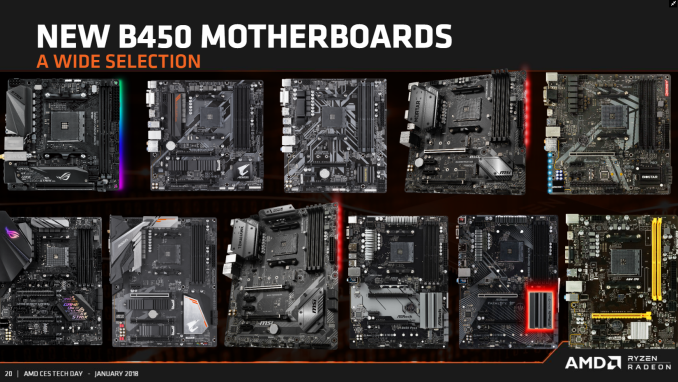
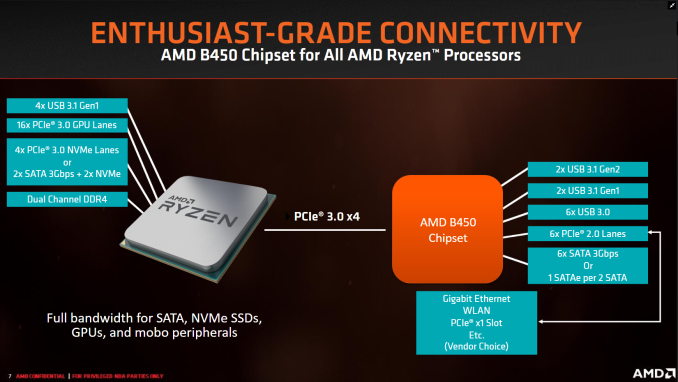
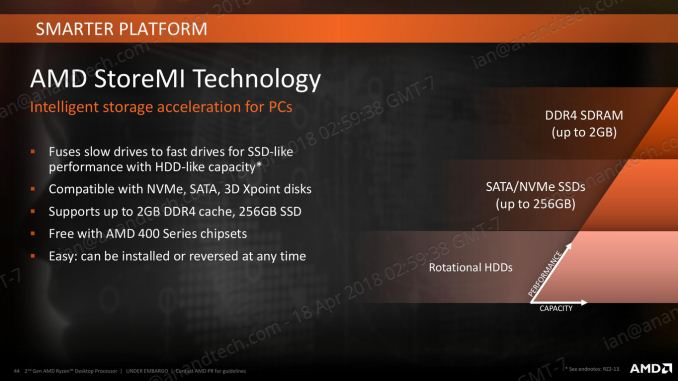
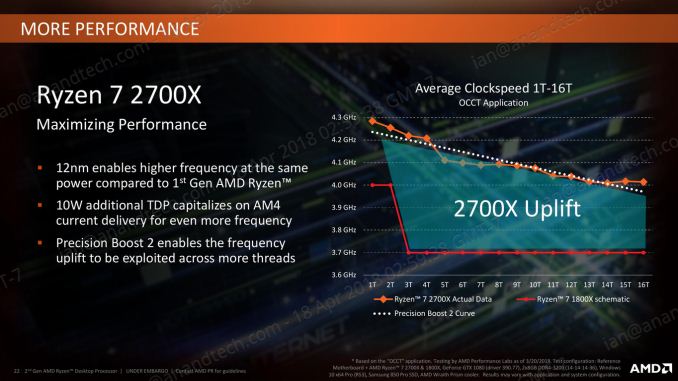
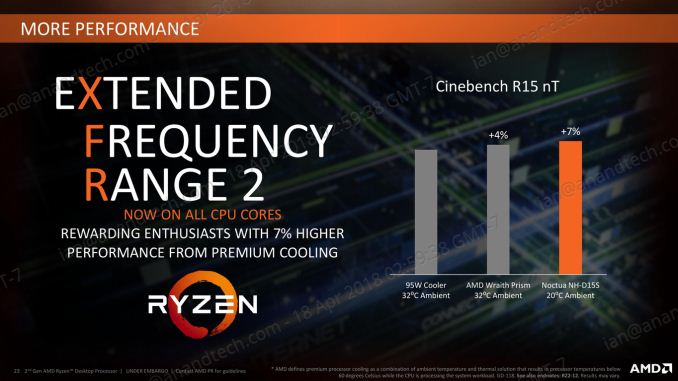
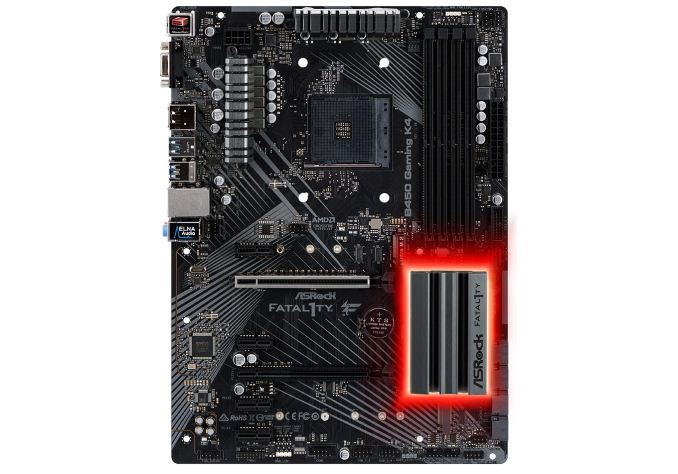

_thumb.png)
_thumb.png)
_thumb.png)
_thumb.png)
_thumb.png)
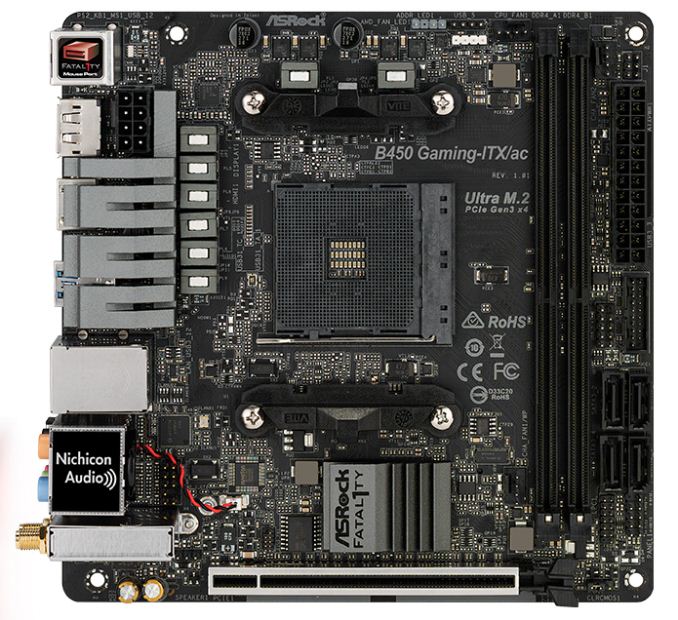
_thumb.png)
_thumb.png)
_thumb.png)
_thumb.png)
_thumb.png)
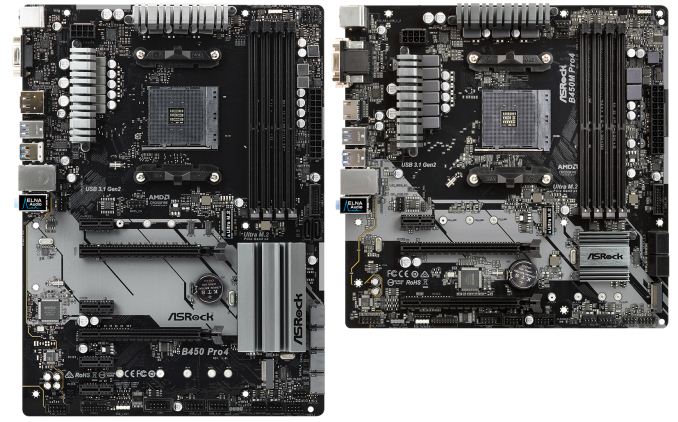
_thumb.png)
_thumb.png)
_thumb.png)
_thumb.png)
_thumb.png)
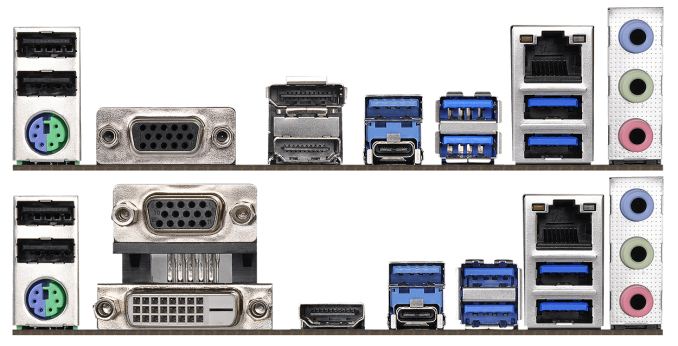
_thumb.png)
_thumb.png)
_thumb.png)
_thumb.png)
_thumb.png)
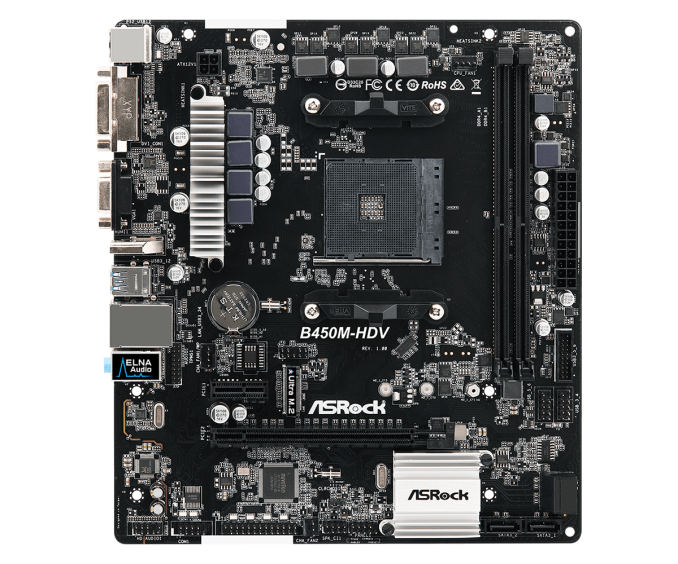

_thumb.png)
_thumb.png)
_thumb.png)
_thumb.png)
_thumb.png)
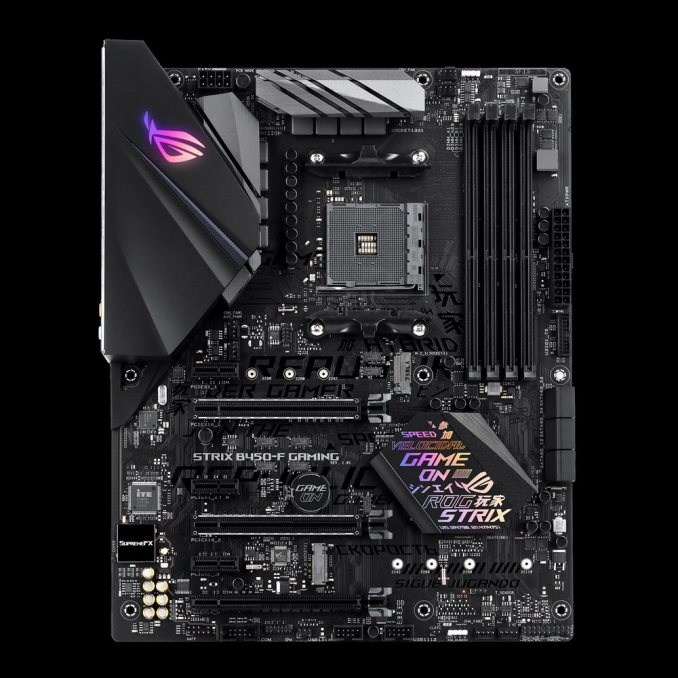
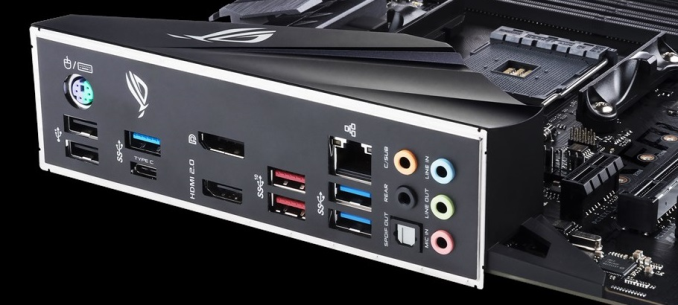
_thumb.jpg)
_thumb.png)
_thumb.jpg)
_thumb.png)
_thumb.jpg)
_thumb.png)
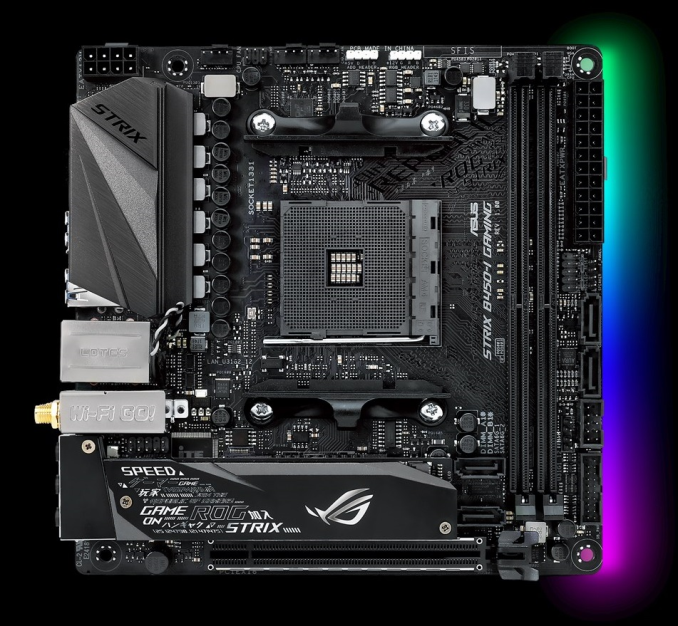
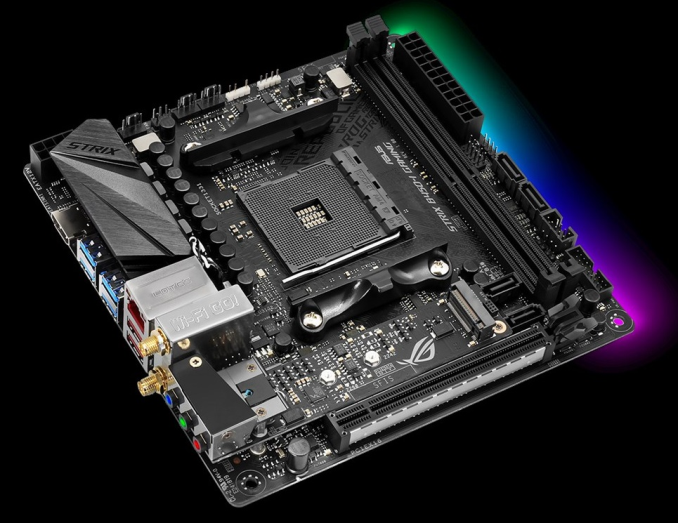

_thumb.jpg)
_thumb.jpg)
_thumb.jpg)
_thumb.jpg)
_thumb.jpg)
_thumb.jpg)
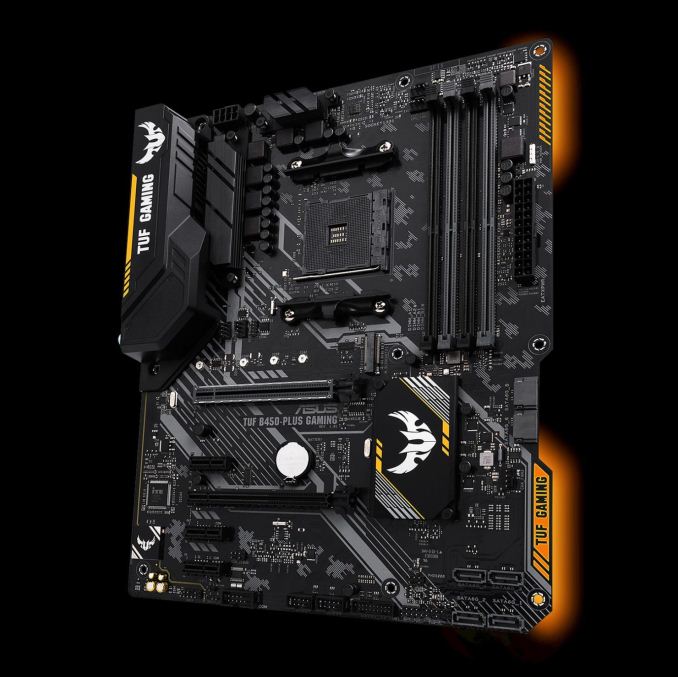
_thumb.jpg)
_thumb.jpg)
_thumb.jpg)
_thumb.jpg)
_thumb.jpg)
_thumb.jpg)
_thumb.jpg)
_thumb.jpg)
_thumb.jpg)
_thumb.jpg)
_thumb.jpg)
_thumb.jpg)
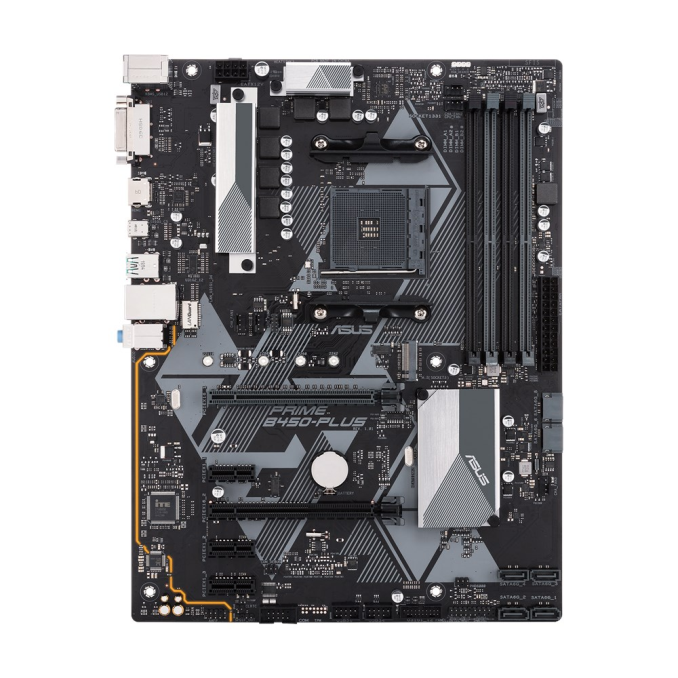
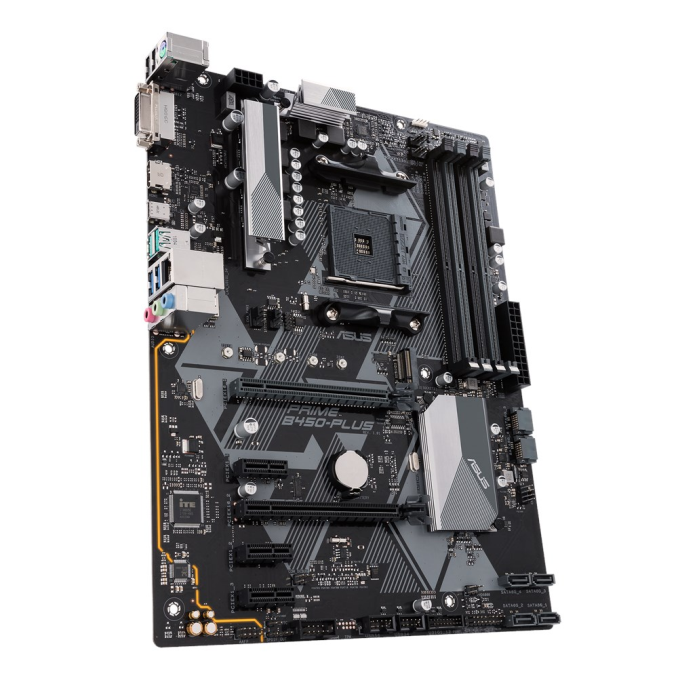

_thumb.png)
_thumb.png)
_thumb.png)
_thumb.png)
_thumb.png)
_thumb.png)
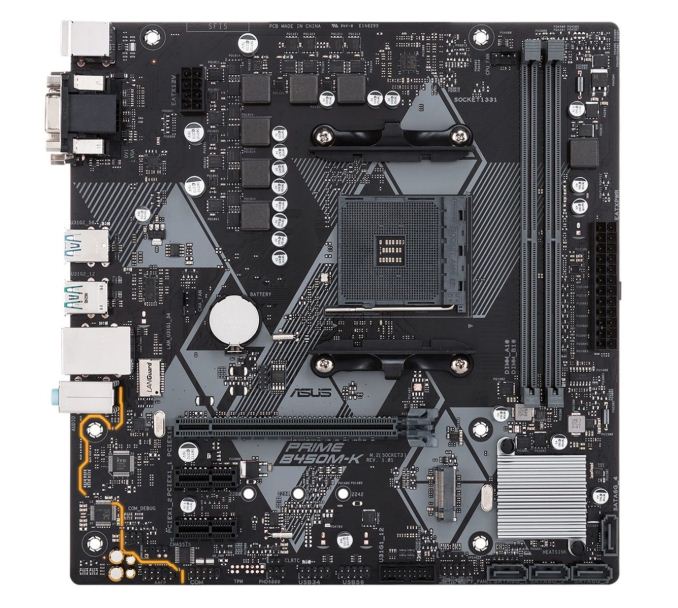
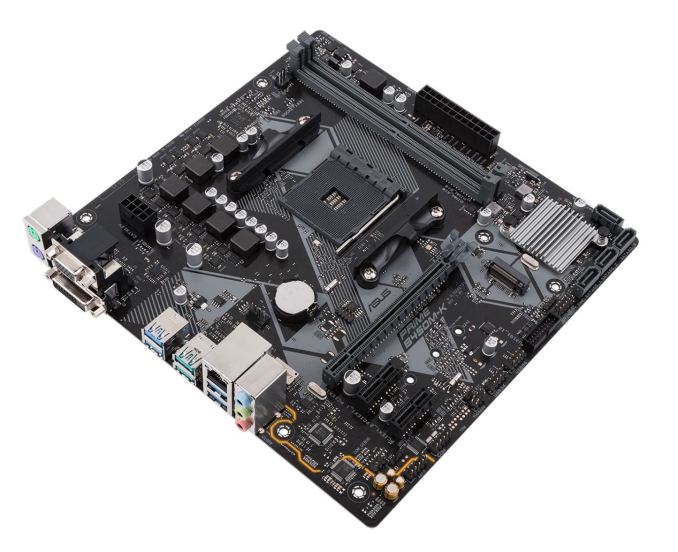

_thumb.png)
_thumb.png)
_thumb.png)
_thumb.png)
_thumb.png)
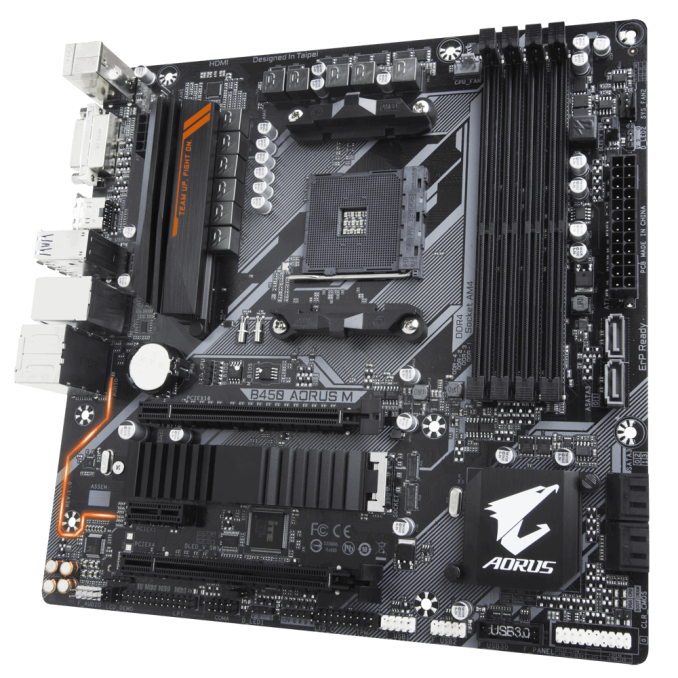
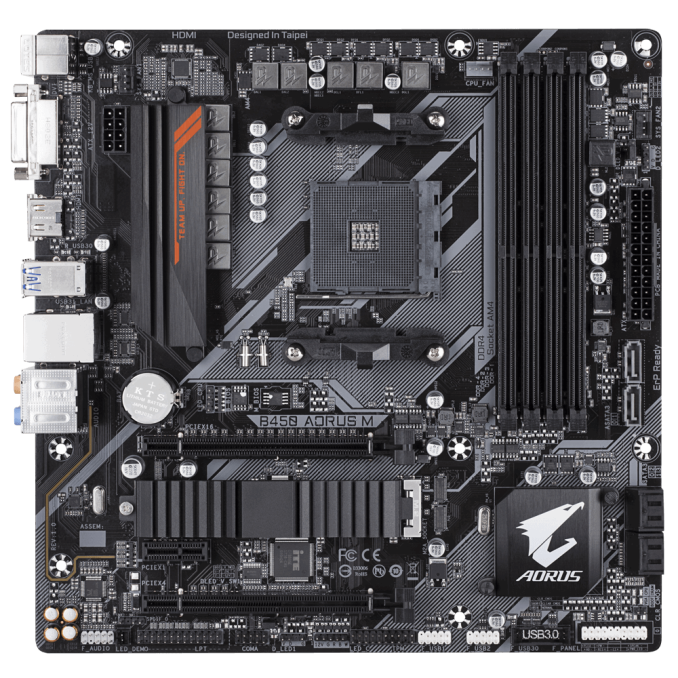

_thumb.png)
_thumb.png)
_thumb.png)
_thumb.png)
_thumb.png)
_thumb.png)
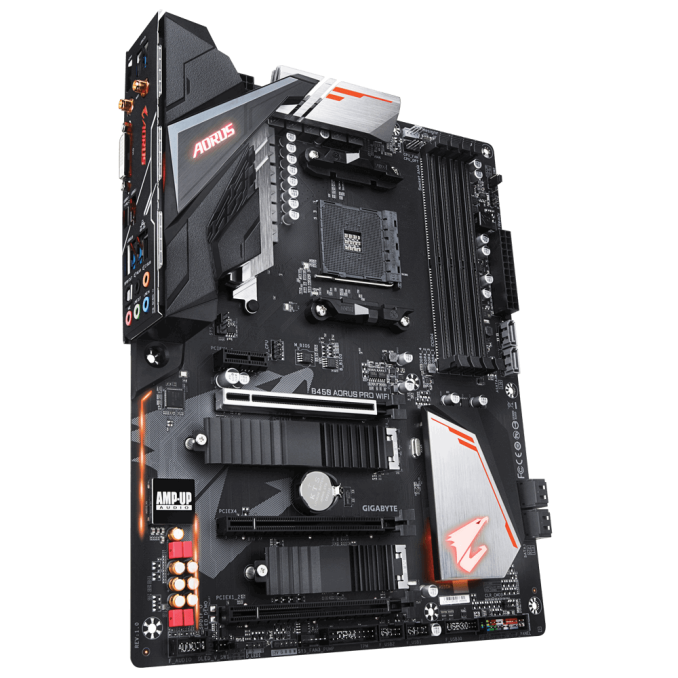
_thumb.png)
_thumb.png)
_thumb.png)
_thumb.png)
_thumb.png)
_thumb.png)
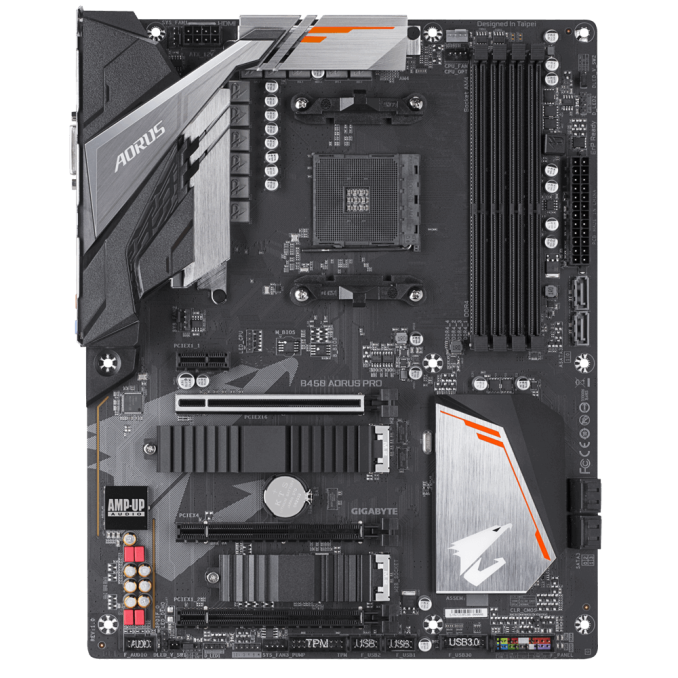
_thumb.png)
_thumb.png)
_thumb.png)
_thumb.png)
_thumb.png)
_thumb.png)
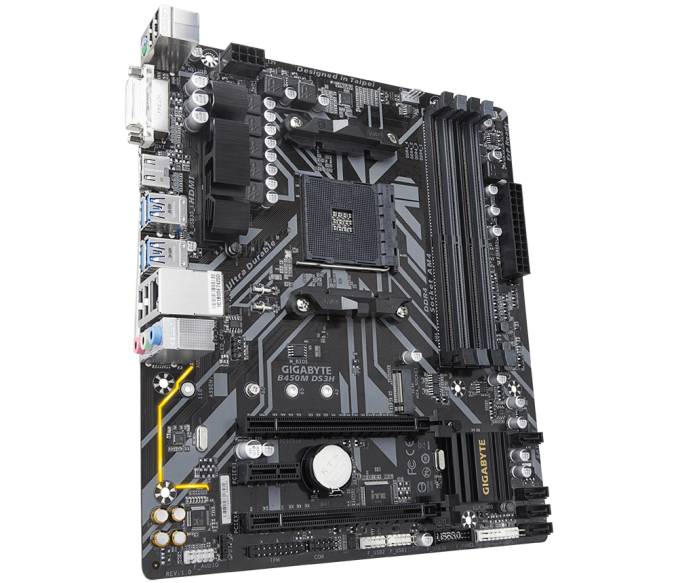
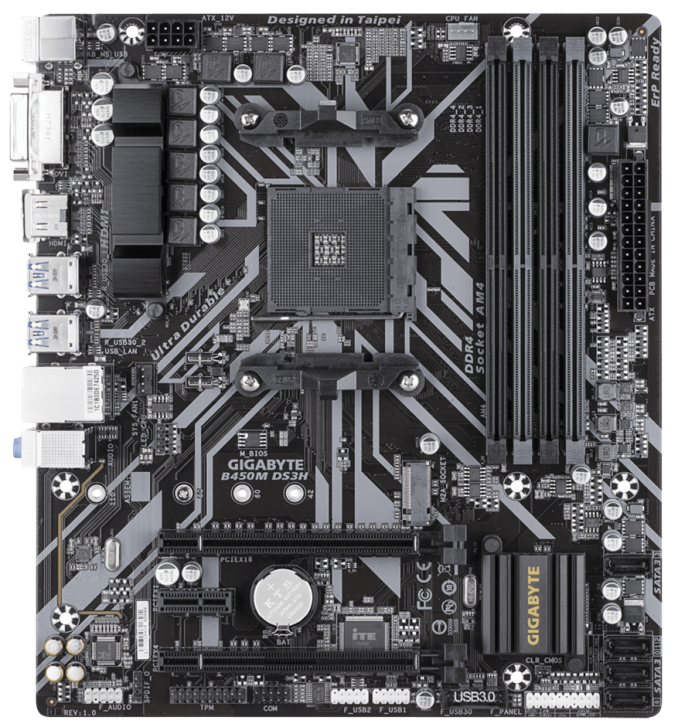

_thumb.png)
_thumb.png)
_thumb.png)
_thumb.png)
_thumb.png)
_thumb.png)












